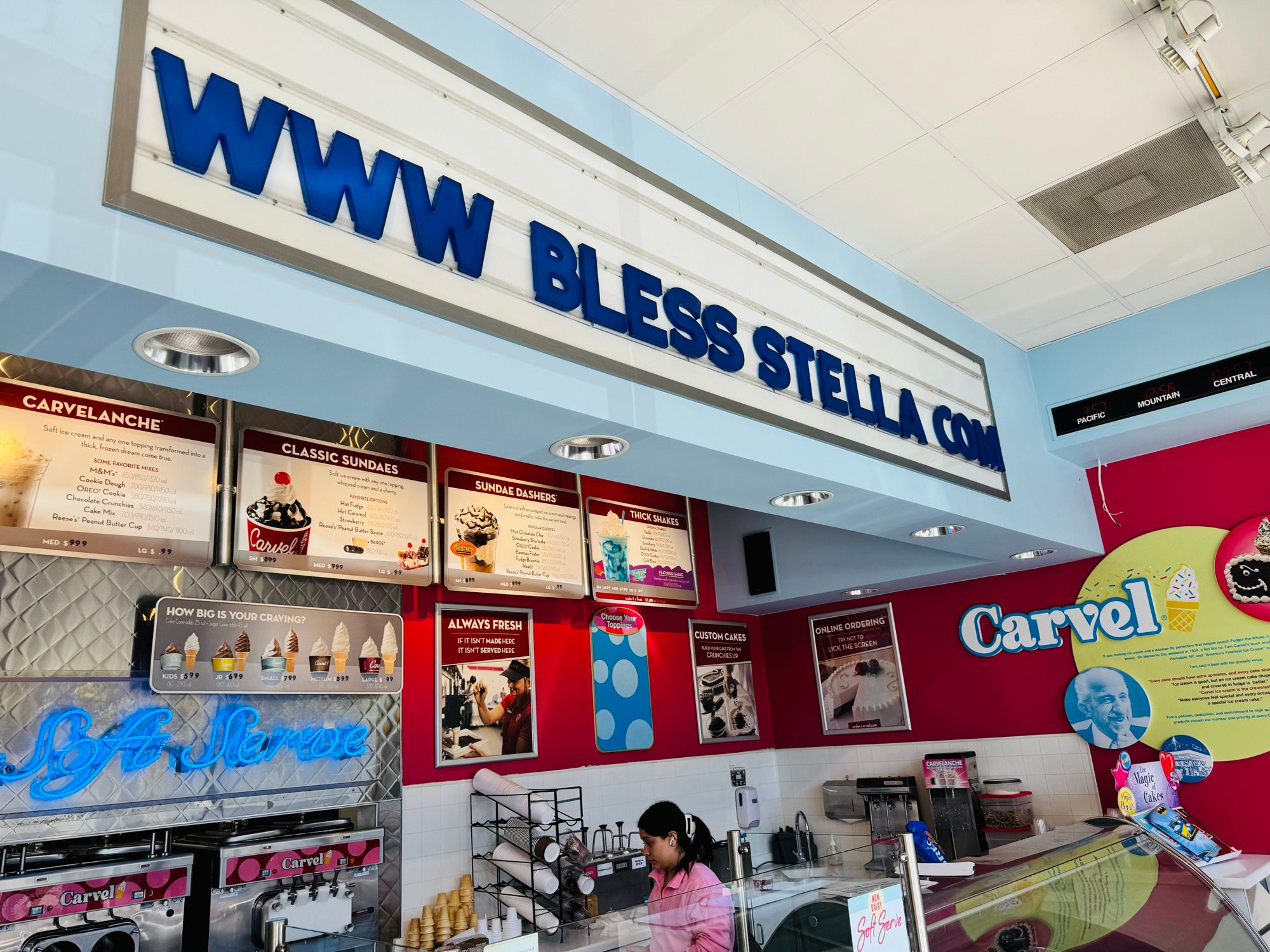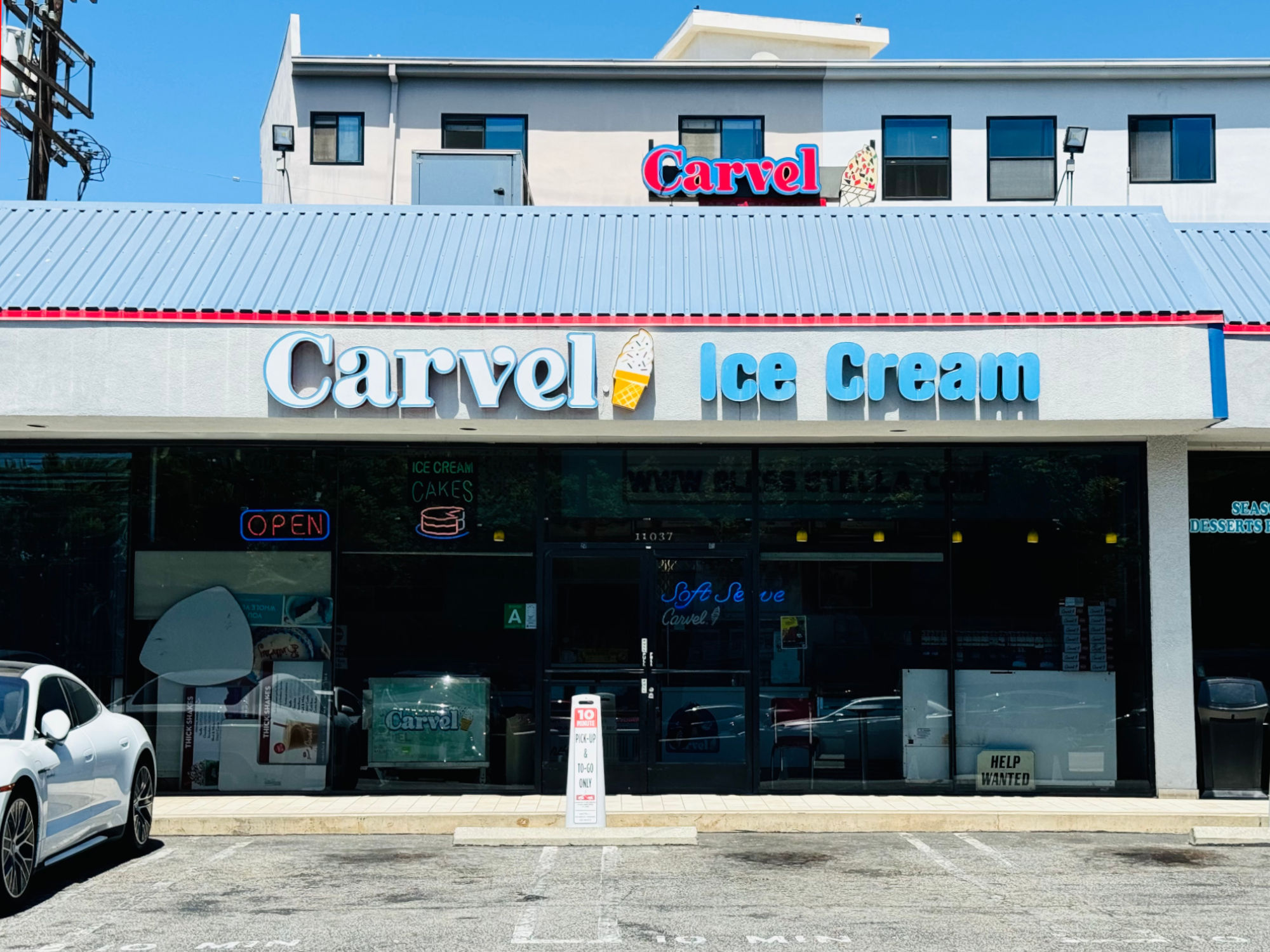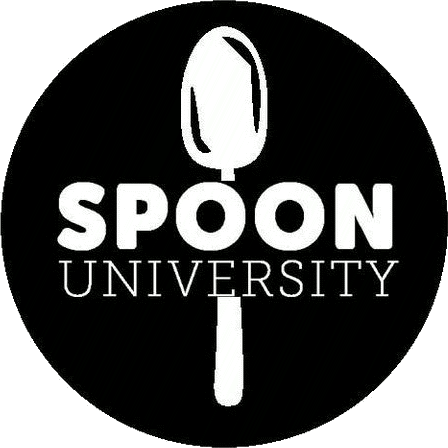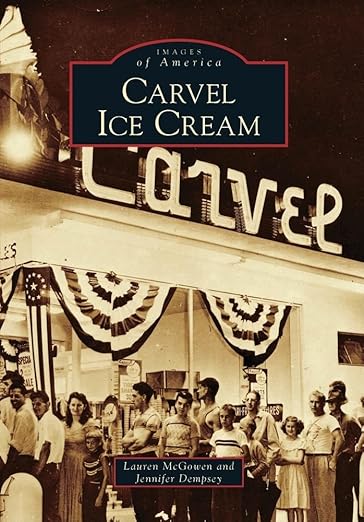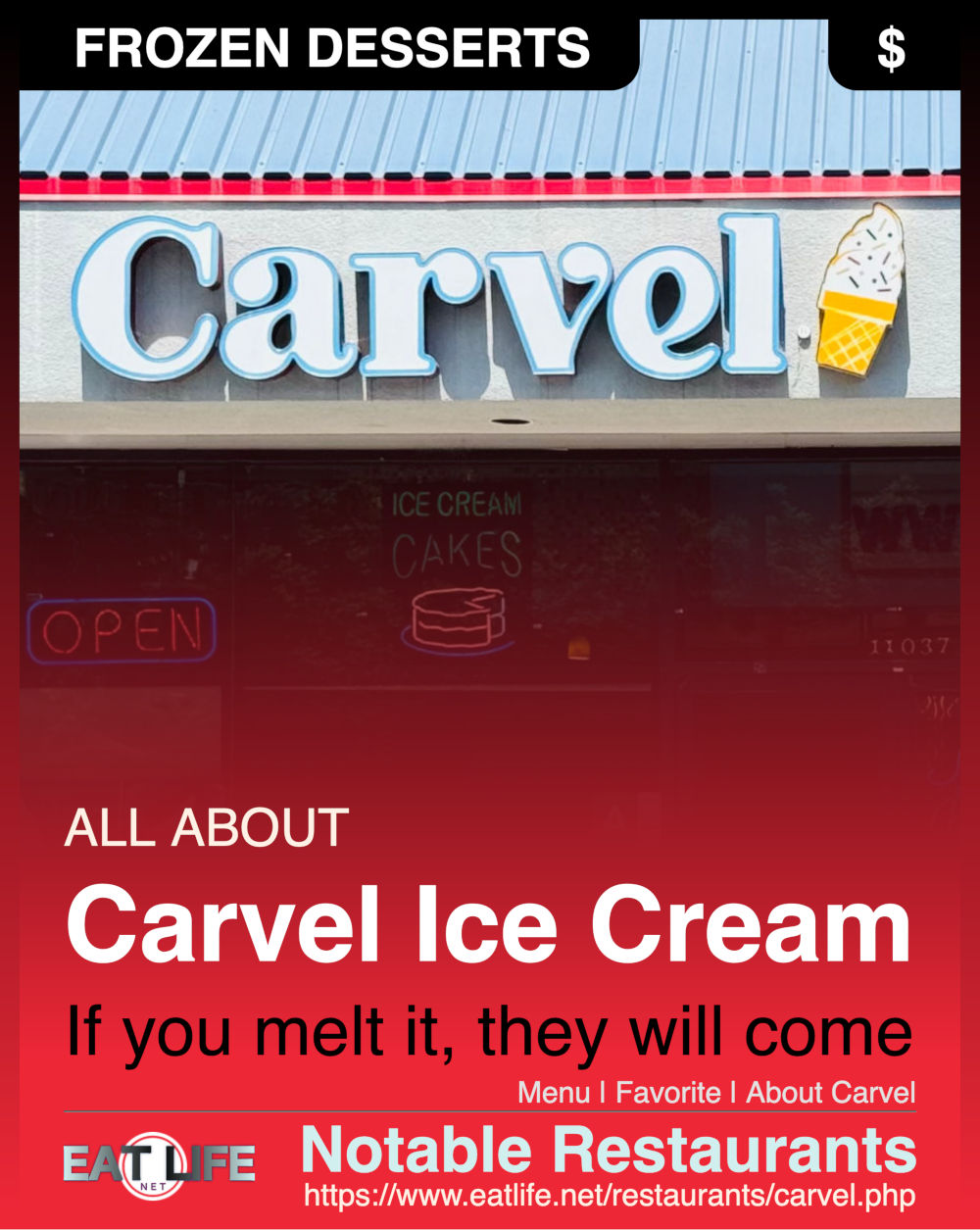1934 Memorial Day weekend. Tom Carvel's ice cream truck got a flat tire, he pulled over and began selling the slightly melted ice cream at the site of the breakdown. Within two days, Carvel had sold his entire stock. Much to his surprise, people preferred ice cream softer. He realized that a fixed location and soft (as opposed to hard) frozen desserts were the way to go. The rest is history. 2024 was their 90th year Anniversary!
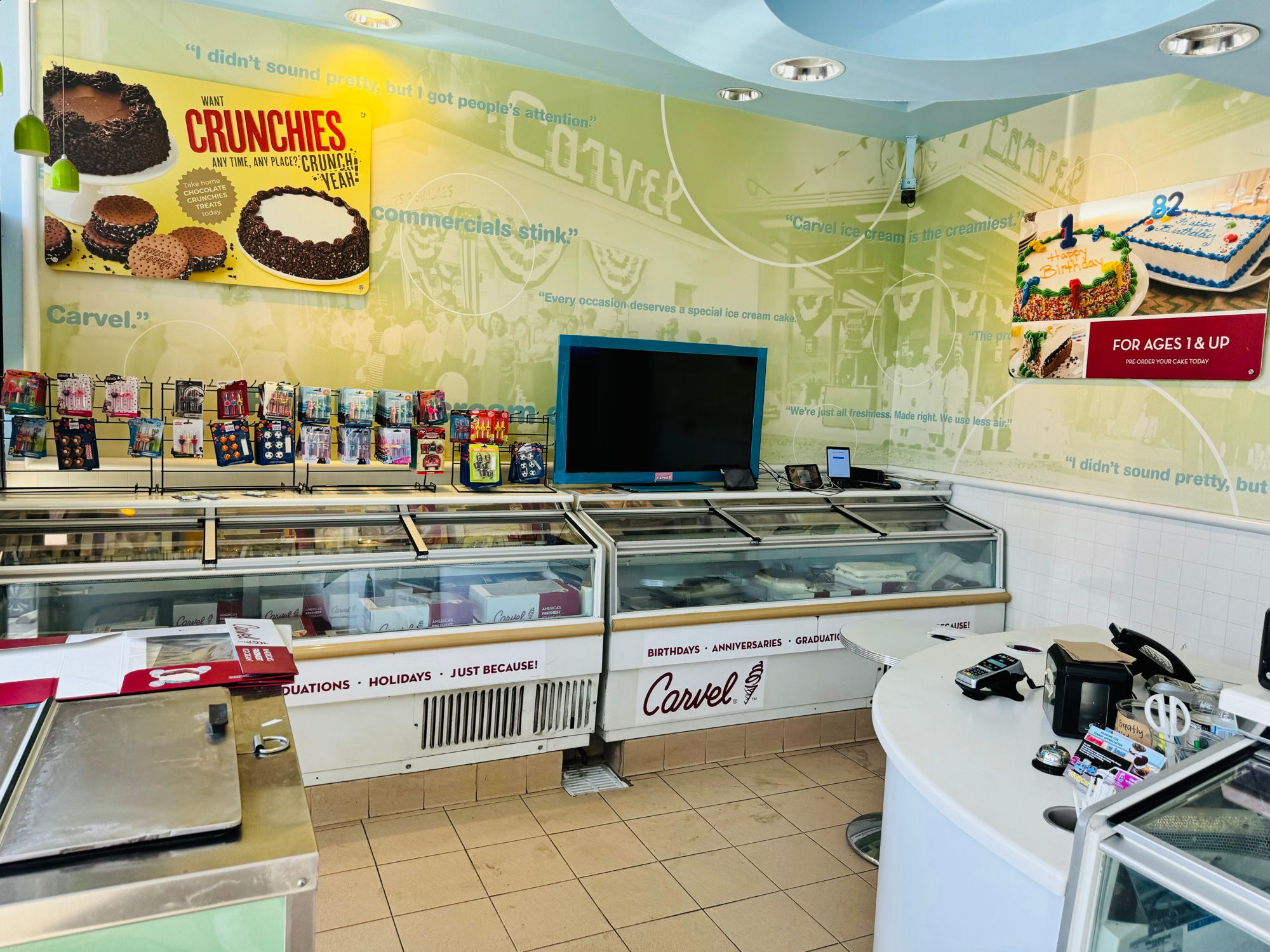
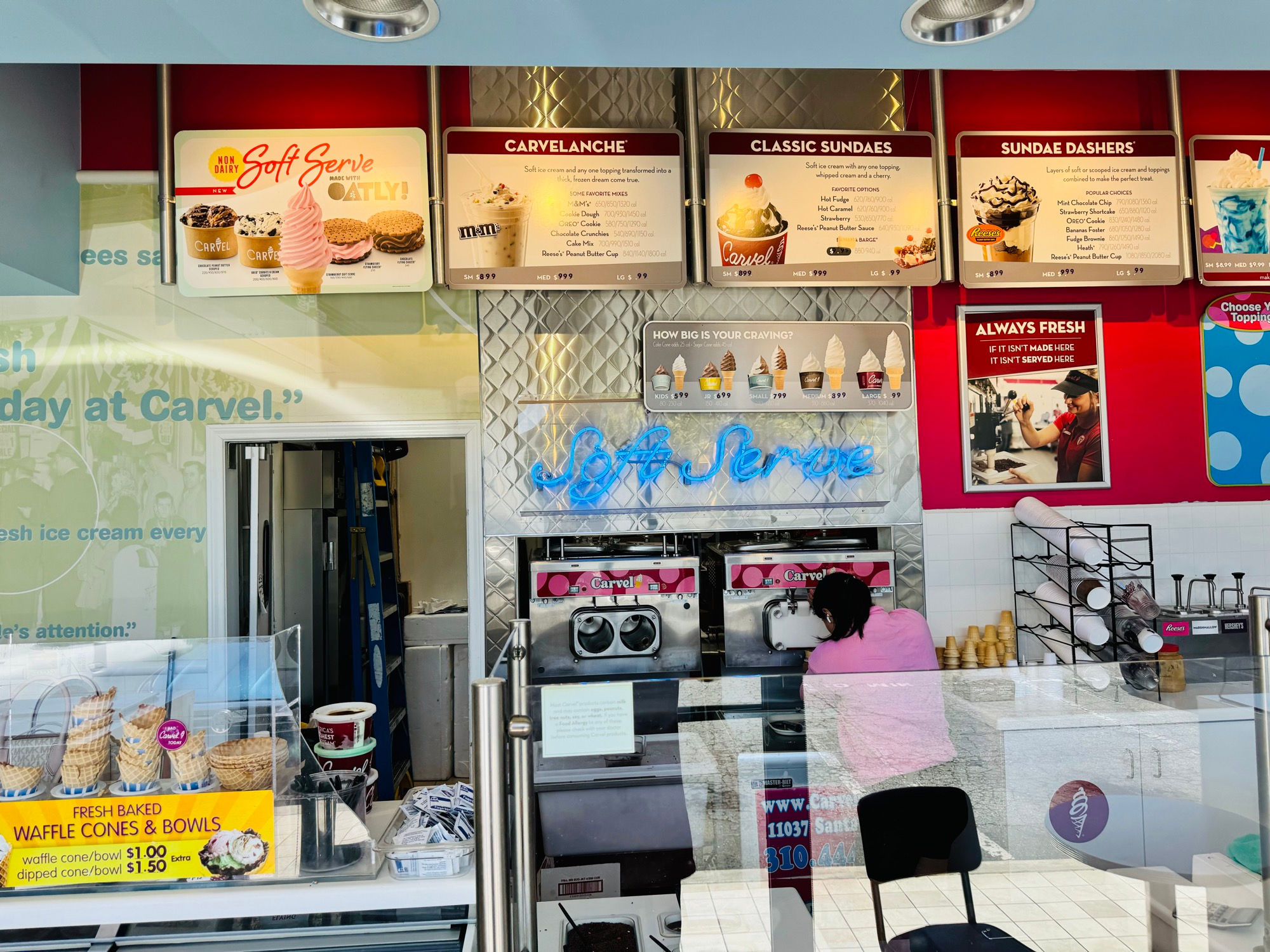
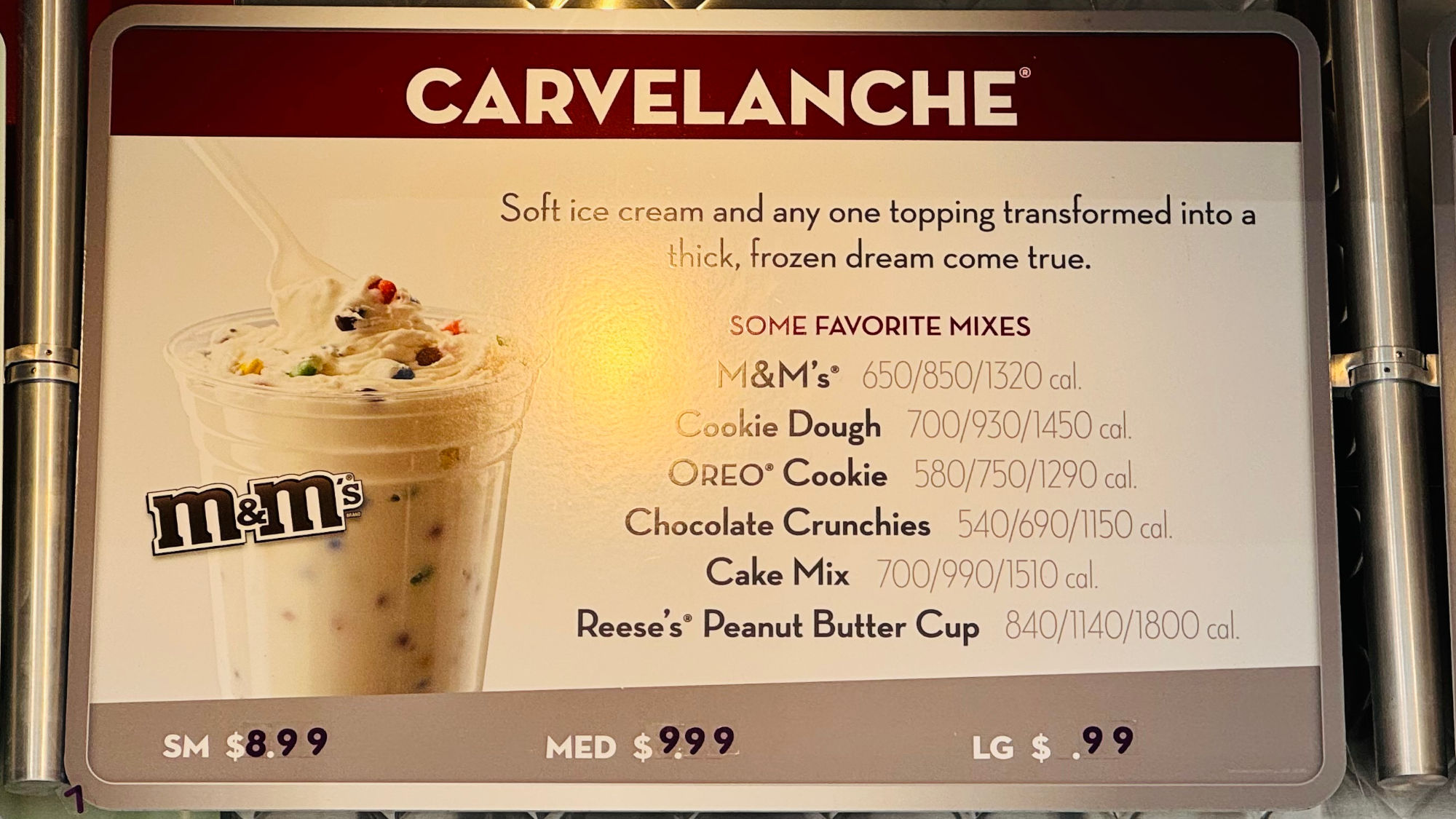
Soft ice cream and any one topping transformed into a thick, frozen dream come true.
- M & M's
- Cookie dough
- Oreo Cookie
- Chocolate Crunchies
- Cake Mix
- Reese's Peanut Butter Cup

Soft ice cream with any one topping, whipped cream and a cherry.
- Hot Fudge
- Hot Caramel
- Strawberry
- Reese's Peanut Butter Sauce
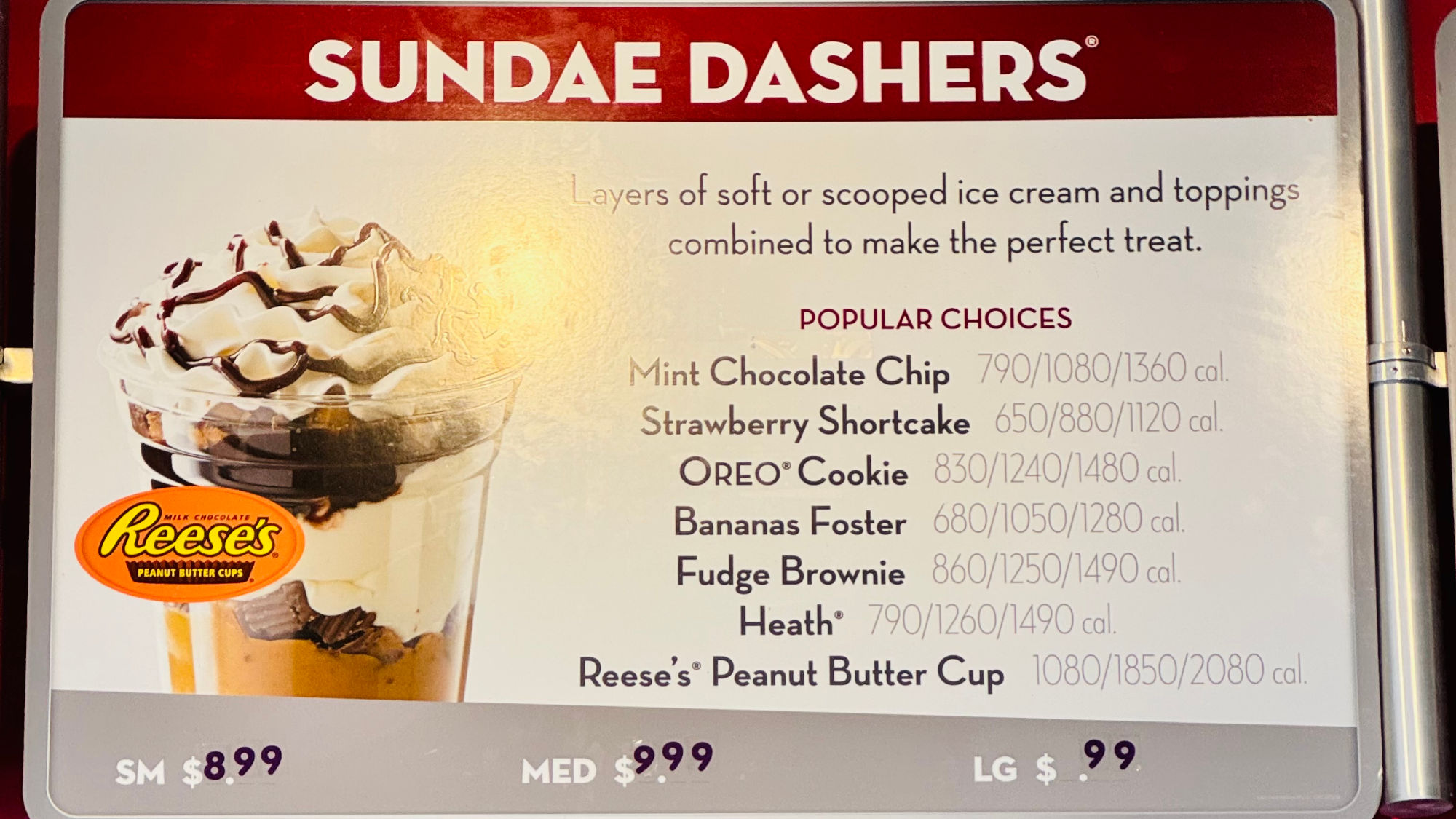
Layers of soft or scooped ice cream and toppings combined to make the perfect treat.
- Mint Chocolate Chip
- Strawberry Shortcake
- Oreo Cookie
- Bananas Foster
- Fudge Brownie
- Heath
- Reese's Peanut Butter Cup
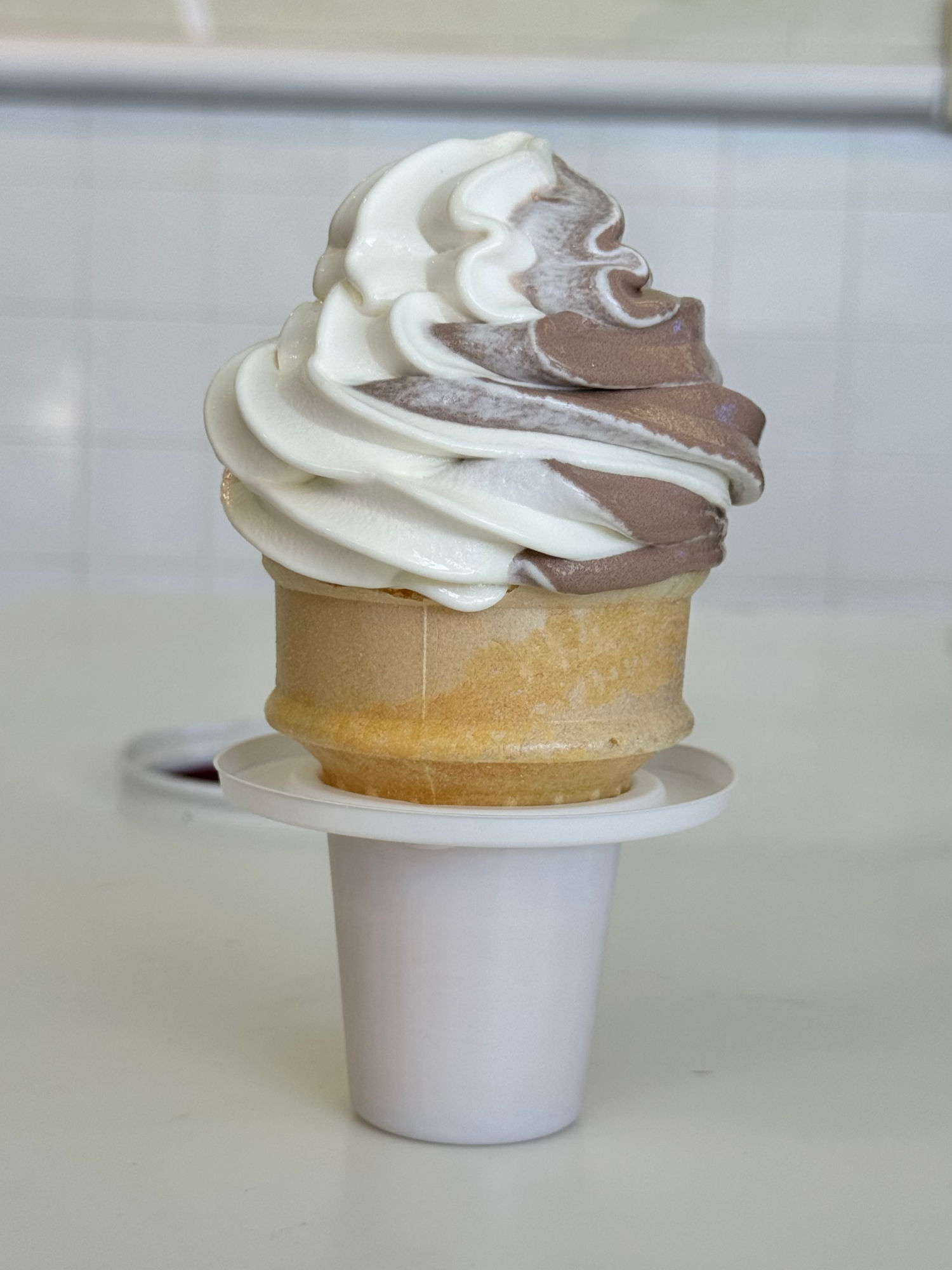
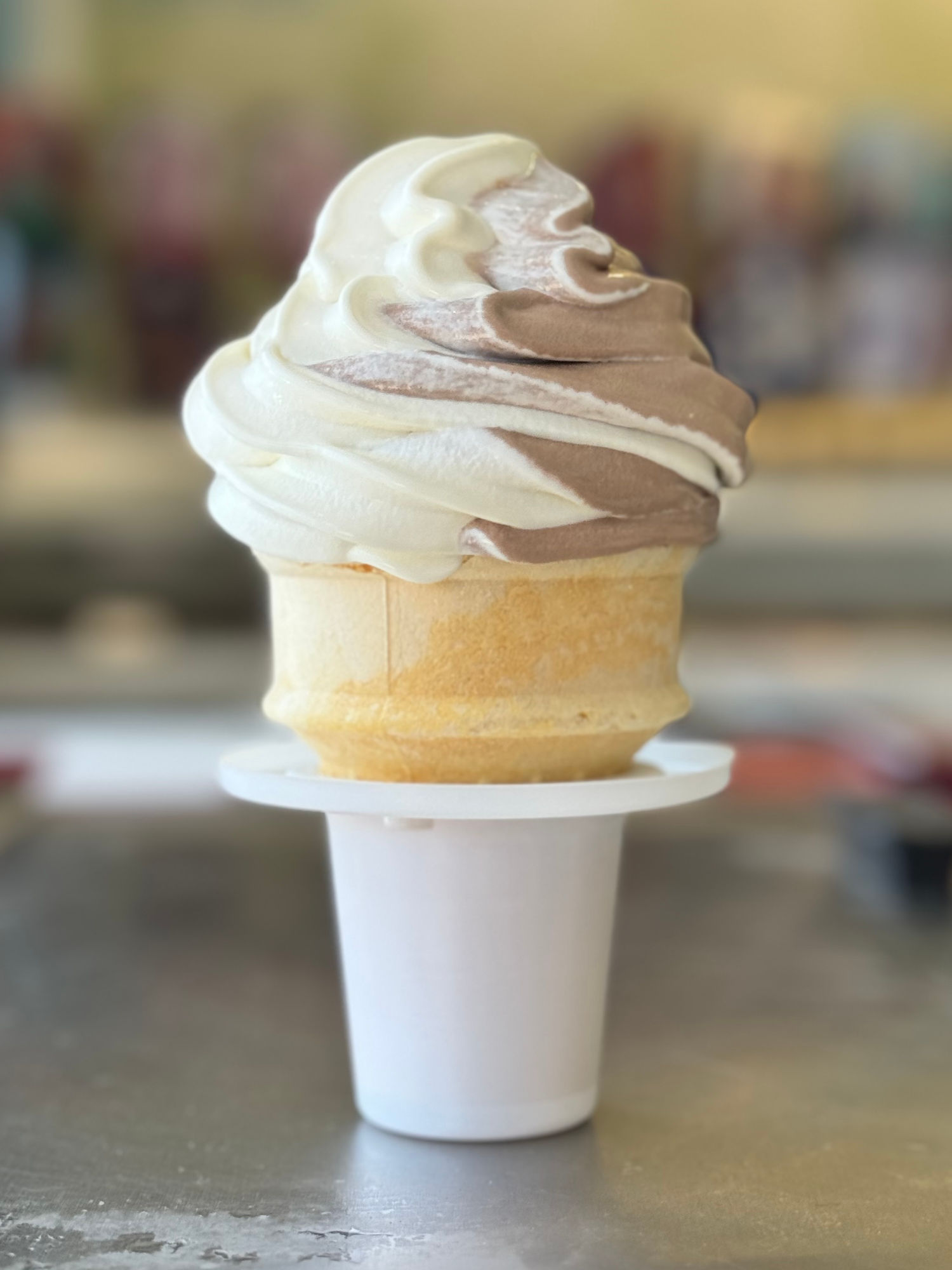
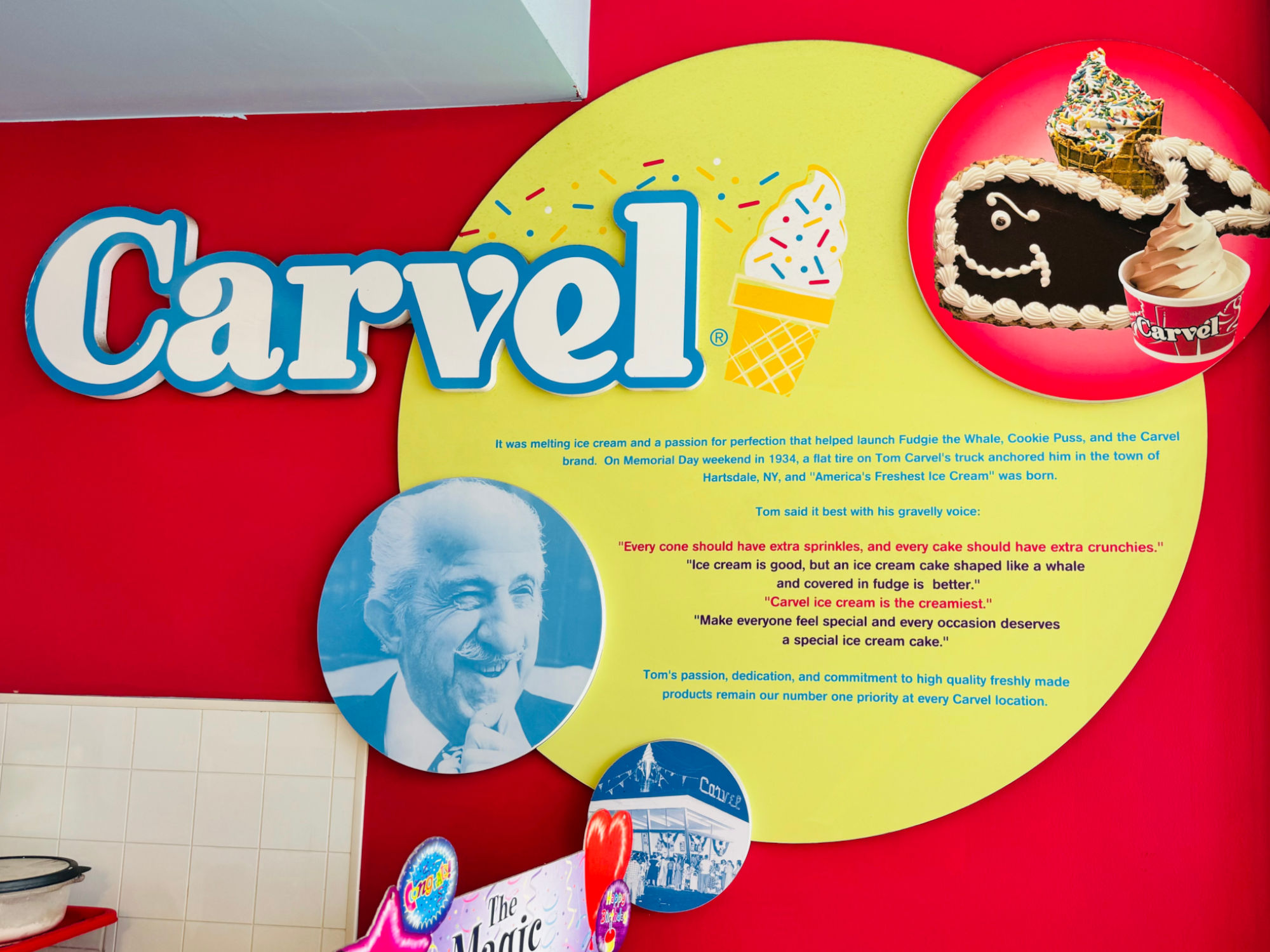
It was melting ice cream and a passion for perfection that helped launch Fudgie the Whale, Cookie Puss, and the Carvel brand. On Memorial Day weekend in 1934, a flat tire on Tom Carvel's truck anchored him in the town of Hartsdale, NY, and "America's Freshest Ice Cream" was born. Tom said it best with his gravelly voice:
- Every cone should have extra sprinkles, and every cake should have extra crunchies.
- Ice cream is good, but an ice cream cake shaped like a whale and covered in fudge is better.
- Carvel ice cream is the creamiest.
- Make everyone feel special and every occasion deserves a special ice cream cake.
CarvelIf you melt it, they will come.
It all started during Memorial Day weekend in 1934. When Tom Carvel's ice cream truck got a flat tire, he pulled over and began selling the slightly melted ice cream. Much to his surprise, people preferred it softer. And the rest, as they say, is history. Today, our delicious treats and classic ice cream cakes are a staple at birthdays, holiday parties, or any occasion worth celebrating.
CARVEL HAS ALWAYS LED THE INDUSTRY Innovation is a part of our culture. From the moment Tom Carvel invented soft ice cream to today, we have constantly come up with new flavors, cakes, treats, machines, ideas and more. 1906 Thomas A. Carvel is born in Athens, Greece on July 14th. 1929 Tom Carvel begins selling ice cream from his vending truck. 1934 Nation's first retail ice cream company is founded. 1936 Carvel Corporation is formed. Tom Carvel patents a “no air pump” super-low temperature ice cream. 1947 Carvel is the first to franchise a retail ice cream shop in the United States. 1951 Carvel introduces the Flying Saucer and celebrates its 100th shoppe. 1956 Carvel starts selling ice cream novelties at the first ice cream supermarket ever. 1969 Carvel launches a complete line of all-kosher products. 2001 Carvel is sold to affiliates of Roark Capital Group. 2002 The company sets the Guinness World Record for Largest Ice Cream Scoop Pyramid. 2004 FOCUS Brands is created. 2005 Carvel adds Sundae Dashers to its menu. 2013 Branded Sundae Dashers are added to the menu. 2014 Carvel celebrates its 80th Anniversary. 2017 Fudgie the Whale celebrates his 40th birthday. 2024 Carvel celebrates its 90th Anniversary.
CarvelHow It's Made
In an imported, pre-packaged, flash frozen world, true freshness stands out. That’s why we have always made everything right in the shoppe. It may take time, effort and passion, but the end result is a smooth, creamy flavor that can’t be matched anywhere else.

WIKIPEDIACarvel
American ice cream franchise owned by Focus Brands. Carvel is best known for its soft-serve ice cream and ice cream cakes, which feature a layer of distinctive "crunchies". It also sells a variety of novelty ice cream bars and ice cream sandwiches. Its slogan is "America's Freshest Ice Cream".Carvel operates a chain of 320 ice cream outlets, primarily concentrated in the Northeast United States and Florida. It has locations across 19 states and Puerto Rico in high-traffic areas such as airports, malls, and sports arenas. The company also sells ice cream cakes in more than 8,500 supermarkets.
Since 2001, the corporation has been owned by Roark Capital Group and operated as part of Focus Brands. As of 2020, the Carvel corporate website reports "more than 400 franchise and foodservice locations in more than 20 states and over 10 countries."
WikipediaNovelty Ice Creams
Carvel popularized various novelty ice cream items, such as the "Flying Saucer", a circular ice cream sandwich; the "Icy Wycy", a paper cone of sherbet on a stick; "Brown Bonnet" and "Cherry Bonnet", frozen vanilla ice cream on a sugar cone dipped in a sweet, waxy confection; the "Tortoni", a cup of vanilla ice cream covered with toasted coconut and topped with a maraschino cherry; and the "Lollapalooza", cylindrical ice cream on a stick covered with colored sprinkles, as well as the "Mamapalooza" and "Papapalooza".Carvel was founded and operated by Tom Carvel for its first 60 years. In 1929, Carvel borrowed $15 ($270 today) from his future wife Agnes and used it to buy and operate an ice cream truck. Over Memorial Day weekend of 1934, Carvel's truck had a flat tire in Hartsdale, New York. Carvel sold his custard at the site of the breakdown. Within two days, Carvel had sold his entire stock, much of it partly melted. He realized that a fixed location and soft (as opposed to hard) frozen desserts were good business ideas. In his first year, he grossed over $3,500. By 1937 he had a custard stand at the Hartsdale site, with a freezer which allowed him to make his frozen custard. By 1939, the gross revenue was over $6,000.
In the early 1940s, Tom Carvel traveled, selling custard at carnivals, while his wife Agnes ran the Hartsdale location. During World War II, he ran the ice cream stands at Fort Bragg in North Carolina, gaining expertise in refrigeration technology. He invented and patented a freezer, the "Custard King", and in 1947 sold 71 freezers at $2,900 each. Some freezer purchasers defaulted on payments on the units. Upon investigation, Carvel found that they needed to run their businesses more efficiently, choosing poor locations and only sometimes maintaining high health standards. Carvel decided that the best course was to participate in running the operations of his freezer customers. He later claimed this led him to develop the concept of franchising.
In 1949, Carvel began franchising under the name "Carvel Dari-Freez". By the early 1950s, the company had over 50 stores. New franchisees undertook an 18-day training program at the "Carvel College of Ice Cream Knowledge", and were sent an in-house magazine called "The Shopper's Road". In addition, Carvel provided building plans for franchises, which were initially stand-alone glass-fronted stores.
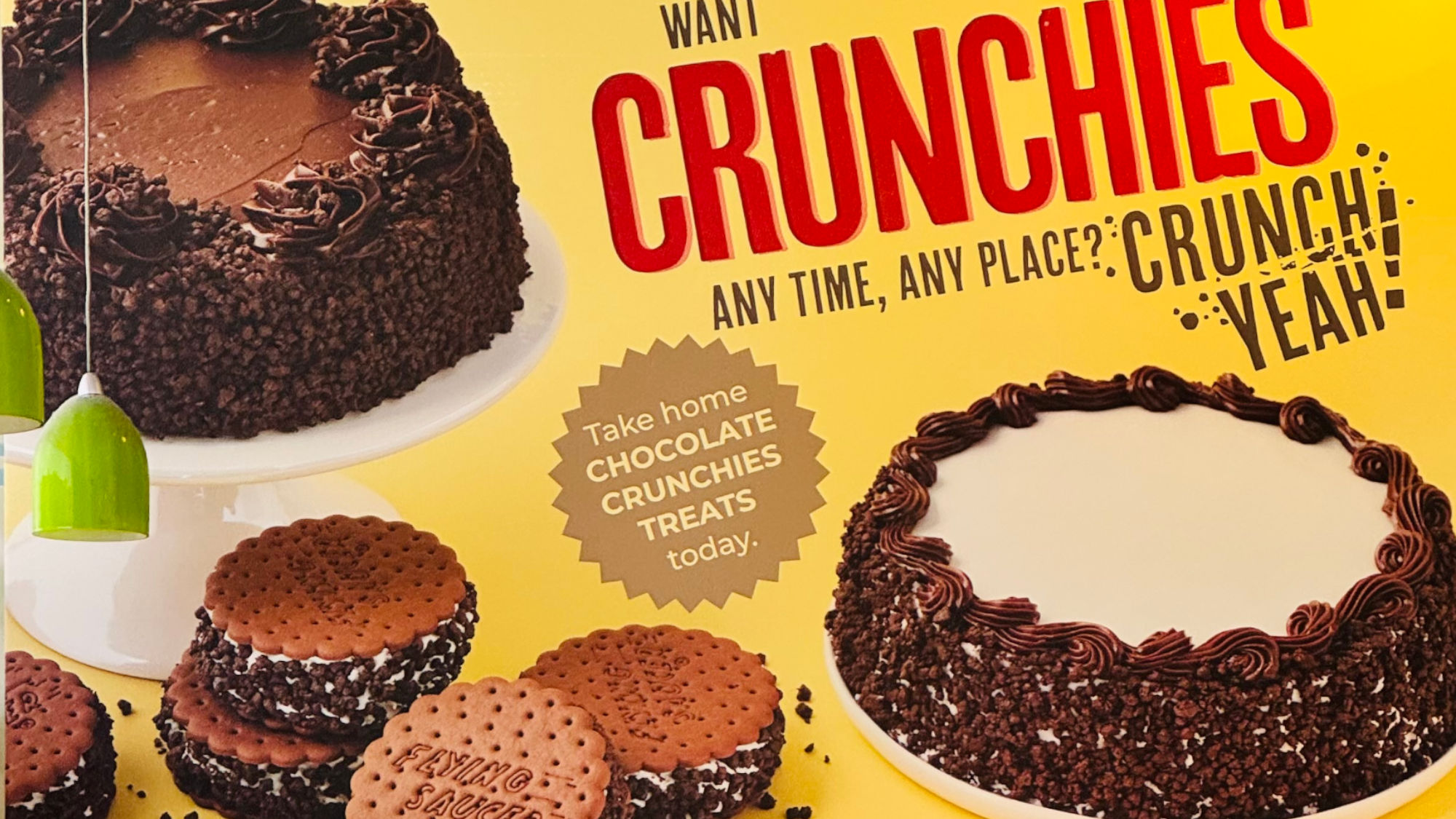
Tom Carvel: King of Soft-Serve
Tom Carvel was a self-made success story whose name is synonymous with the product he created-soft-serve ice cream.Amercia Comes Alive!Carvel (1906-1990)
He was among the early adopters of using a franchise system to grow his business. He was also the first chief executive officer of a company who served as his own spokesperson/commercial announcer for radio and television. He proved that movie-star looks and a professional “announcing voice” are not necessary for building product sales. Carvel's gravelly voice did just fine in creating effective commercials. “Thinny thin ice cream for your fatty fat friends” may perhaps be the most memorable of his ad lines (though today public opinion would not take kindly to this tag line)Ice Cream Truck Breakdown
Carvel was known for occasionally embellishing his past, but the story goes that on Memorial Day weekend in 1934, his ice cream truck broke down in Hartsdale, New York. He pulled into a parking lot and sold the beginning-to-melt ice cream to weekend drivers as they passed by. From this experience he gleaned two valuable lessons:
- He could succeed with a single location for selling, which would save on wear-and-tear and having to travel with ice cream.
- People loved the partially melted ice cream he sold from the truck. He wondered if there was a way to mass produce a soft ice cream.
The lot he pulled into was outside a pottery store in Westchester County. Carvel made a deal with the store owner. He would pay a small rental fee so that he could keep the ice cream cold by plugging in his refrigeration equipment on weekends.
Roadside sales from this location were strong enough that two years later, Carvel purchased the pottery store and created his first permanent ice cream shop. (This location remained a Carvel store until the property was sold in 2006. The shop was torn down soon after to be replaced by a Japanese restaurant.)
The Invention of Soft Ice Cream
Soft ice cream-also known then as custard-was first created by British chemists who discovered a method to double the air within ice cream to create a softer product. Tom and his brother, Bruce, knew that soft ice cream existed. But they wanted to create a machine that could dispense the softer product. To keep the ice cream truck going and to keep the ice cream product cool enough, Tom had learned a lot about how refrigerators work. His brother Bruce was also good at tinkering, so they started experimenting.The machine they developed could fast freeze the ingredients, and then small cup- or cone-size quantities of soft ice cream could be pumped out. Carvel eventually patented his invention, and went on to hold over 300 patents, trademarks and copyrights on various ice cream-related items and products.
Marriage
In 1937 Tom married Agnes Stewart. Agnes was born in Aberdeen, Scotland in 1908. She and her family came to New York City via Montreal where she attended business school.With the approach of World War II, Carvel was sent to Fort Bragg, North Carolina. His experience with refrigeration was welcomed by the military, and he quickly found himself assigned to work with the food service people. This deepened his experience, and he learaned even more about freezing systems.
Building the Business
After World War II, Carvel was ready to grow his business. His goal was to market the soft-serve ice cream machine for use in restaurants. Ice cream stores were never part of the plan. But machine sales got off to a rough start. The restaurateurs had trouble training their staff to use them so that they ice cream dispensed properly. Carvel saw that he needed to take his business a different direction to maintain product control.He read about a new way to grow businesses via “franchises.” (Singer Sewing Machine Company is thought to be the first company to sell franchises. They did so in the 1850s.) By the early twentieth century, food businesses like White Castle (1923), A&W (1925), Kentucky Fried Chicken (1930), and Howard Johnson (1935) were beginning to experiment with the system. Franchises were structured in different ways, but in general, the main company sold to aspiring business owners the supplies, the recipes, the logo, and business promotion plans to launch independent stores.
Sundae School
In 1947, Carvel sold his first franchise. As an immigrant himself, Tom Carvel welcomed others new to the United States to buy into his franchise operation. Within the next few years, the company had 25 more franchised stores. To train those who wanted to buy a franchise, he opened Carvel College of Ice Cream Knowledge (also known as Sundae School).At one point, Carvel considered expanding into hospitality, and he bought a motel in Yonkers. He soon decided against taking his business in that direction, but he found a good use for the motel. When future franchisees came in for training, he had motel rooms for them, and some of the bigger rooms could be used as classrooms.
By the 1980s, there were more than 700 Carvel outlets along the East Coast.
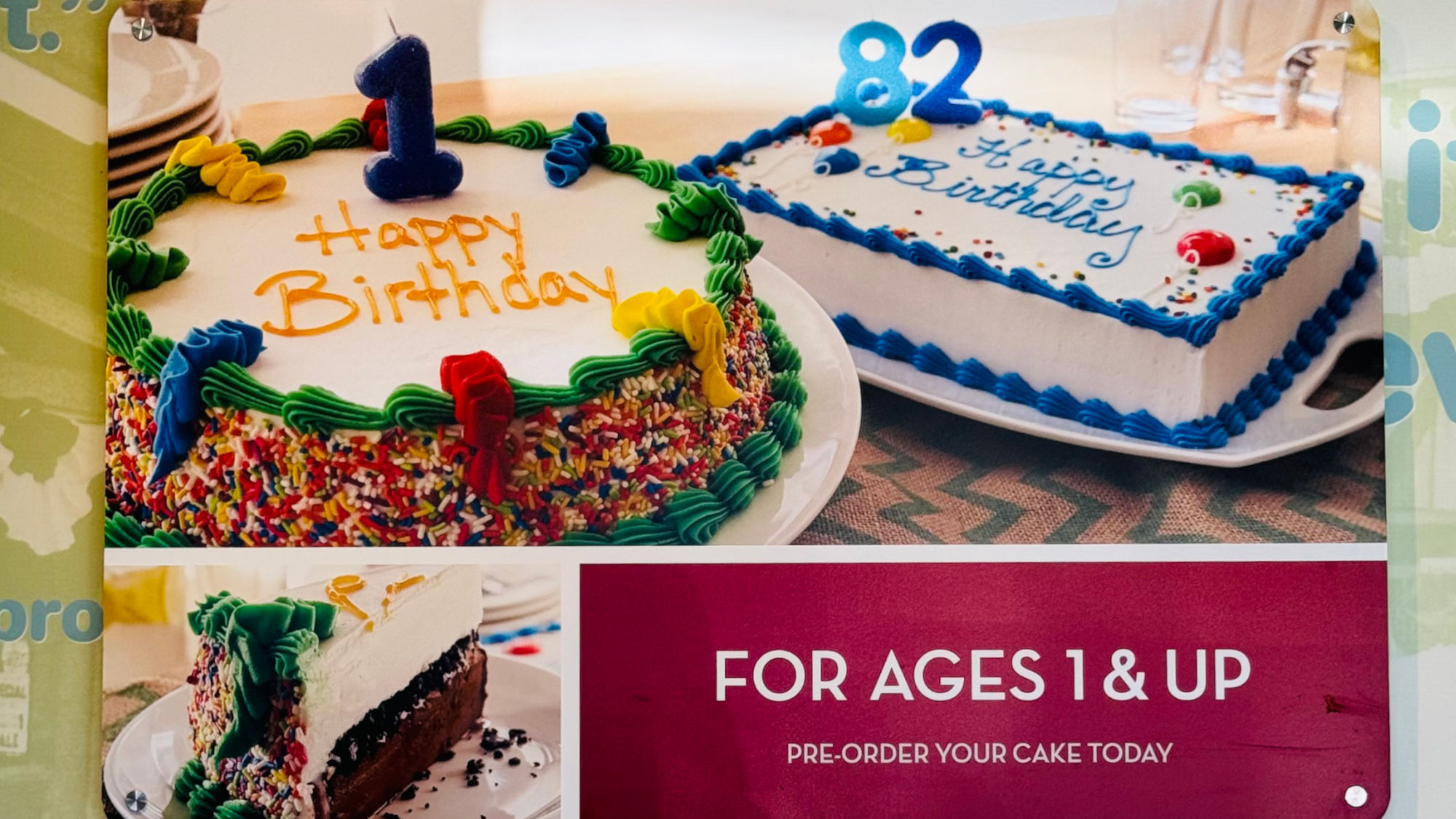
- Thomas Carvel started his ice cream empire with a loan from his future wife.
In 1910, Tom Carvel was just 4 years old when he moved to America along with the rest of his family from Greece. As a young man, Carvel tried his hand at a number of odd jobs, including test-driving Studebaker cars. But after he was misdiagnosed with tuberculosis, doctors recommended that Carvel get out of the automotive business and out of New York City. He moved to Westchester, borrowed $15 from his soon-to-be-wife, Agnes, and in 1934, a 26-year-old Carvel started selling ice cream out of a truck.- Soft-serve was invented when a truck broke down.
Carvel's business almost went bust that first year. On Memorial Day weekend, in Hartsdale, Carvel's truck broke down and the ice cream started to melt. Carvel hurried to sell what he could and quickly found that heat-softened ice cream was a hit. He called the product "soft-serve" and sold it all summer right out of the broken down truck in a pottery store parking lot. It turned out that customers loved the stationary stand and the slightly softened ice cream; Carvel earned $3500 (more than $60,000 in today's money).- Carvel's soft-serve machine was the first of many patents.
Following that fortuitous breakdown in 1934 (for what it's worth: Dairy Queen disputes the origin story of soft-serve), Carvel put his mechanical experience to use to build a machine that churned soft-serve-it was the first of more than 300 patents, copyrights, and trademarks that Carvel would acquire during his long career. His original intent was just to sell the machines to other ice cream shops, but when they proved too tricky to operate without Carvel's guidance, he had no choice but to start hiring people himself and launch the Carvel Corporation in 1947, making him the self-proclaimed "father of franchising" in America.- Carvel was an innovator many times over.
In addition to soft-serve, among the many firsts Tom Carvel was responsible for were round ice cream sandwiches, and he was one of the first to offer "buy one get one free" promotions.- At least one of the signature cakes became a cultural icon.
In the '70s, Carvel debuted a line of slight bizarre-looking cakes that included Fudgie the Whale, Hug-Me Bear, and Cookie Puss. Although Fudgie the Whale-advertised as a Father's Day treat-is still the best seller today and they all became part of the cultural lexicon, Cookie Puss had particularly wide-ranging impact. The Carvel-endorsed origin story claimed that the Cookie Puss was an alien who originally went by the name Celestial Person (or "CP")- Tom Carvel's unrehearsed ads helped put the company on the map.
Advertising experts cite Tom Carvel as one of the first executives to voice his own ads on radio and television. "I can't find anyone cheaper than me," Carvel is reported to have said of casting himself. His gravelly voice and imperfect diction was instantly notable and memorable.- Following Thomas Carvel's death, the company fortune was mired in mystery and controversy.
Just days before he died in 1990, 84-year-old Thomas Carvel told a close associate that he had begun to worry that Mildred Arcadipane, his secretary and confidant of 38 years, and Robert Davis, his longtime lawyer, were scheming against him. Despite their years of service, Carvel planned to relieve them of their considerable power within the company. He died of a heart attack before he had the chance to do so. In the decades since his death, Carvel's fears have been proven well-founded. Arcadipane and Davis fought bitterly for years against Carvel's widow Agnes and his niece Pamela over the $67 million estate-and the fighting wasn't always fair. While Agnes attended her late husband's wake, Davis and a hired locksmith broke into the couple's home to search for a will, and in 2007, Pamela-the sole surviving member of the feud-requested that her uncle's body be exhumed for an additional autopsy in an effort to prove he'd been murdered. That request was denied, and later an arrest warrant was issued for Pamela Carvel-who had filed for bankruptcy-for civil contempt.- The original Carvel location lasted over 70 years.
Two years after that fateful breakdown in Hartsdale, N.Y., Thomas Carvel bought a permanent ice cream shop on the very same street. The store, 25 miles north of Manhattan, served up sweet treats for over seven decades. It was also the site of the first ice cream supermarket in 1956. But rising rents and taxes took a toll and in October 2008, the original Carvel closed for good.- Aspiring franchisees learn the ropes during an intensive course at Carvel College.
- The company has a couple world records.
- There was a very short-lived Carvel hamburger franchise.
- You can make the "Crunchies" at home.
A big part of what makes Carvel ice cream cakes so reliably delicious is that crumbly cookie layer between the two flavors. Dedicated fans around the Internet (with a little help from Food Network Magazine) found out that the company uses crumbled flying saucer cookies (from their ice cream sandwiches) mixed with their in-house chocolate dip that hardens. But you can make a pretty good duplicate at home using chocolate Nabisco wafers or Oreo crumbs mixed with Smucker's Magic Shell.
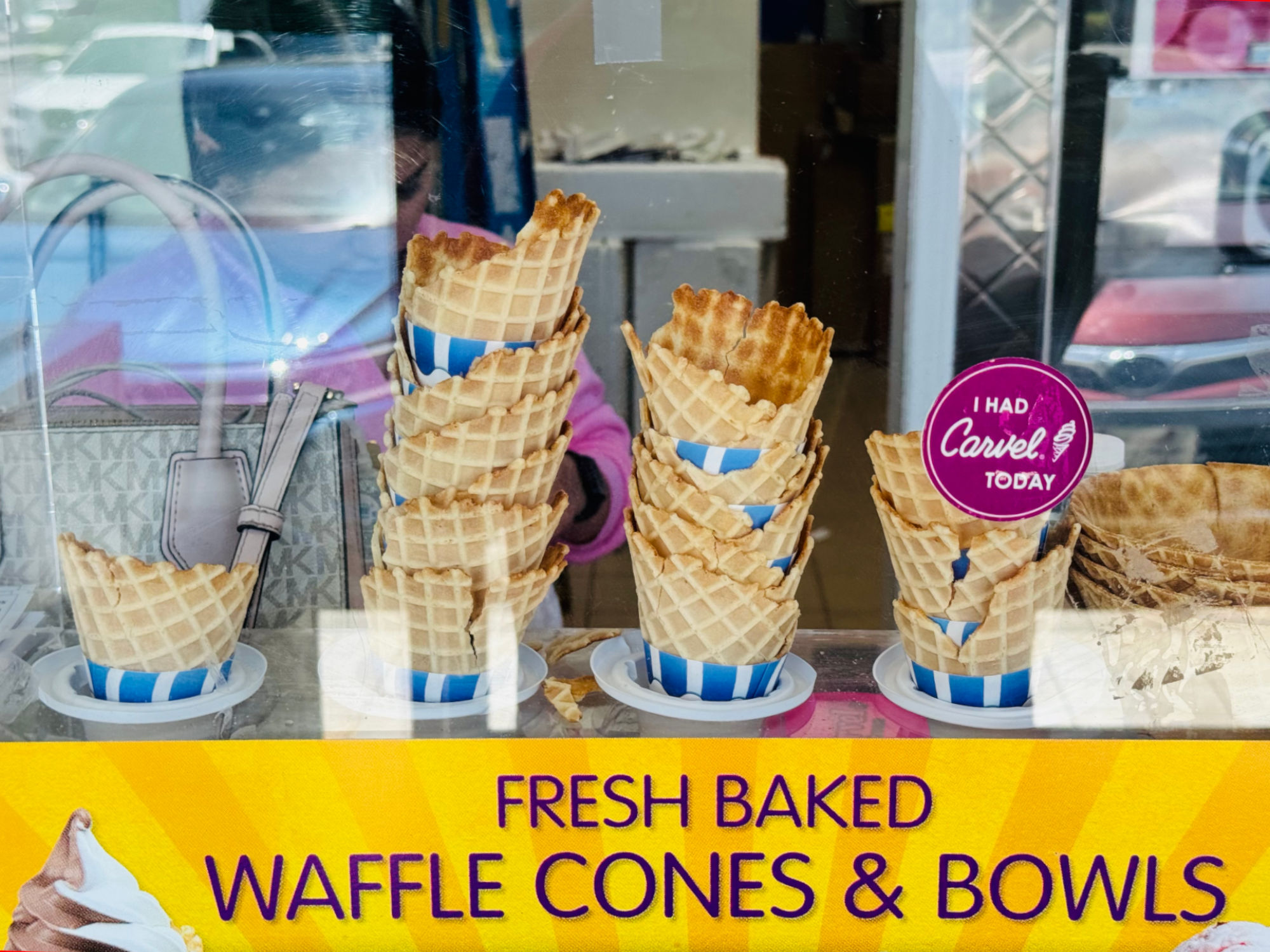
Tasting TableAug 2024
We got the chance to visit the Carvel test kitchen in Atlanta to get the inside scoop on Fudgie's origin story and his rise to fame, and we even got to help whip up a Fudgie cake ourselves. Ready to dive in? Here's everything you need to know about Fudgie the Whale.Like many of Carvel's confections, Fudgie the Whale was born from the ever-churning imagination of the company's founder, Tom Carvel. Sick of making flowery ice cream cakes for Mother's Day, the brand patriarch wanted to come up with a nautical-themed treat for dads, complete with its own personality. The only requirement? It needed to be fudgy.
After a few rounds of trial and error, Fudgie the Whale was born just in time for Father's Day 1977. Inscribed with the now-famous words "to a whale of a dad," the cake became an instant hit from day one. Today, Carvel franchises across the country sell a whopping 100,000 Fudgie the Whale cakes annually (sales still reliably spike around Father's Day), cementing Fudgie as a dessert icon.
Unlike Carvel's other confections, Fudgie the Whale has also become something of a spokesperson, or spokeswhale, if you will. According to Carvel's vice president of marketing Marissa Sharpless, "Fudgie has taken on a core personality as a brand. He's the only character cake that comes to life as a mascot, and people just love him." But don't take her word for it. The mischievous whale is a mainstay on Carvel's social media channels, where he even posts goofy selfies and partakes in social media trends.
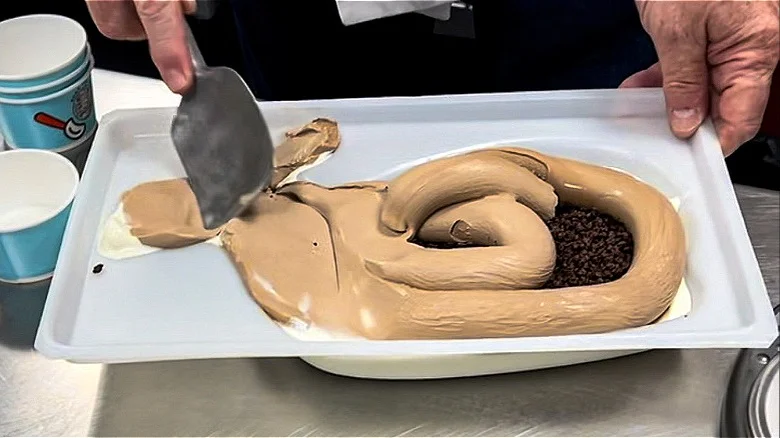
Crafting the perfect Fudgie the Whale cake is all about the measurements. Fudgie may be simple, but that doesn't mean he's an easy confection to crack. When asked about the first time he made a Fudgie the Whale cake, Carvel executive chef Dave Fenner summed up the experience in just one word: "Hard!"
Each element needs to be perfect in order to achieve Fudgie the Whale's signature look. The first essential is the mold. Carvel's proprietary plastic molds serve as the template for Fudgie's shape and need to be able to withstand the sub-zero temperatures of an industrial freezer. The Fudgie the Whale mold is filled with exactly 14 ounces of vanilla soft serve and smoothed into a nice, neat layer. Once the vanilla soft serve is as smooth as freshly packed snow, a hearty 1/2-pound layer of chocolate crunchies is added to the mix, carefully centered to avoid lumpy edges. A layer of chocolate soft serve comes next (also 14 ounces' worth), spread evenly over the top of the crunchies.
The whole cake heads to the freezer to harden before decorating can begin. An uber-thin layer of chocolate fudge douses the entire cake, and a layer of chocolate crunchies is added to the sides for some textural interest. Finally, a semi-frozen icing is piped around Fudgie's border to give him definition, while an eyebrow, blue pupil, and smile are added for a final flourish.
The secrets behind Fudgie the Whale
- Firstly, Fudgie the Whale is made almost entirely of soft serve. There's no sad, dried-out cake layer that turns rock hard after sitting in the freezer. And since he's made from soft serve, the frozen treat is ready to eat much more quickly than if he were made of harder ice cream.
- The second element is the soft serve itself. While most soft serve products contain between 3 and 6% butterfat, Carvel uses more than 10% butterfat in its recipe, resulting in a richer, thicker dessert and more luscious ice cream cake experience.
- Between those layers of butterfat-rich soft serve is the third key element in Fudgie the Whale: those signature chocolate crunchies. This unique addition offers a textural contrast to the smooth soft serve. Thanks to some intense R&D on behalf of the Carvel test kitchen, these chocolaty bites stay crunchy even while placed between layers of soft serve.
Fudgie may be made up of just a handful of elements, but each of those elements has been crafted to create a prime piece of nostalgia.
Tasting TableCraving your own Fudgie the Whale cake?
You'll want to make a beeline for your local Carvel scoop shop. Carvel insists that every Fudgie ice cream cake is made by hand, meaning that you won't find the loveable leviathan on grocery store shelves.
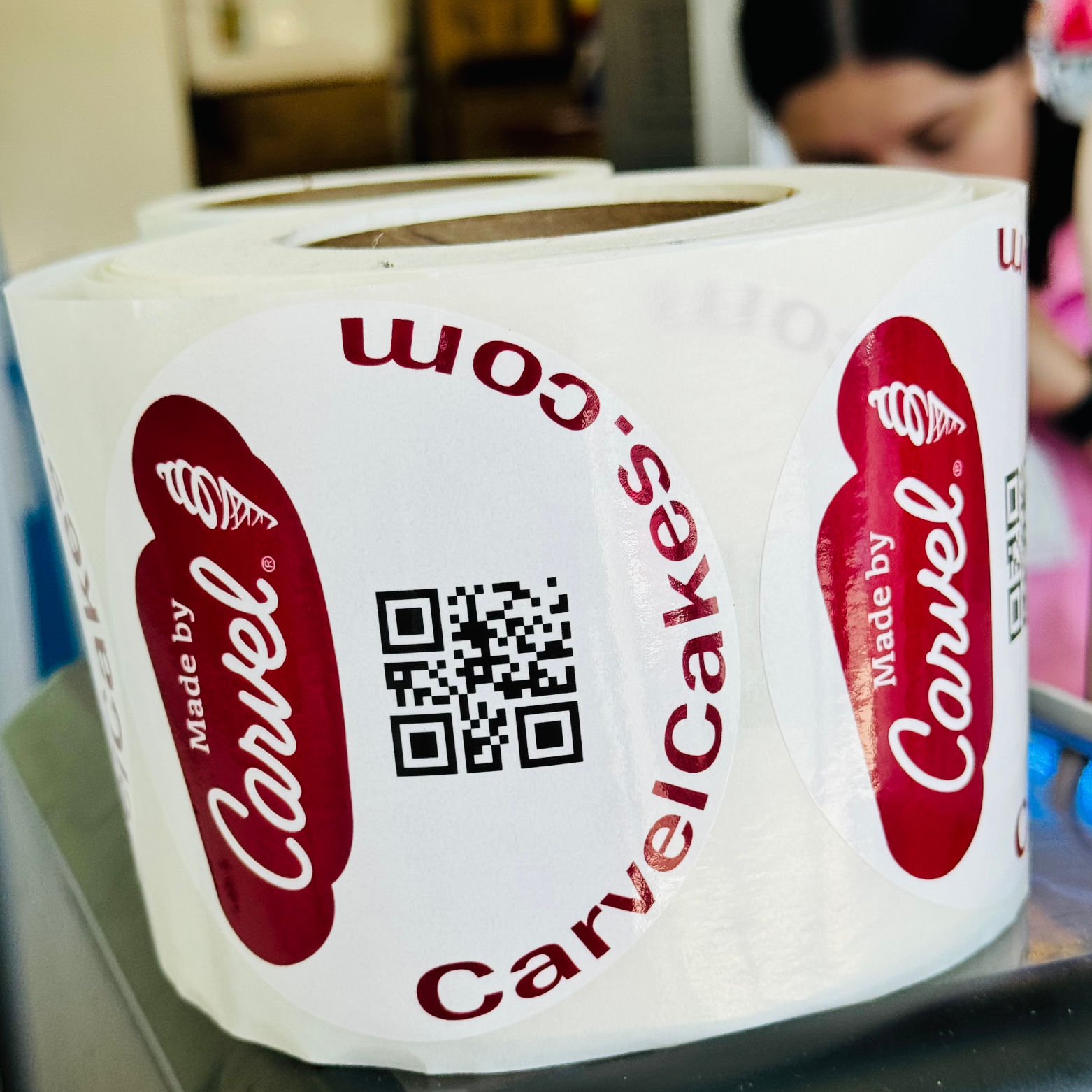
MashedJan 2023
The quintessential rags to riches story of Tom Carvel and his ice cream empire is as remarkable as it is dramatic. Starting out with a modest ice cream van and $20 to his name in 1929, over the years Tom meticulously built his frozen confectionery brand, which during its heyday in 1985 had 865 stores (via Funding Universe). By 2001, Carvel products could also be found in more than 5,000 supermarkets. And while Carvel changed hands before and after its founding father Tom passed away in 1990, the brand remains a cultural staple in the U.S. with over 400 locations across the country.Carvel started out as an ice cream truck
On Memorial Day weekend in 1934, Tom's truck blew a tire while he was doing an ice cream run in Hartsdale, New York. As luck would have it, the nearby pottery shop owner let Tom connect to his electricity to salvage the melting ice cream. After selling out of the sweet treat in just two days, Tom realized that he could make good money from a fixed location. The future ice cream magnate made a deal with the pottery shop owner to keep the truck on his property and grossed $3,500 in his first year. Just two years later, Tom purchased the pottery store and converted it into the first Carvel ice cream shop (via Greek Herald).Tom Carvel may have invented soft serve ice cream
The story goes that after Tom's ice cream truck hit the bump in the road that caused the flat tire, he started to sell his partially-melted ice cream to passers-by. And to his surprise, people loved the product (via America Comes Alive). Tom soon realized that his customers were particularly partial to the creamier and lighter taste of the softer ice cream (via Carvel). Spurred by the interest, the future king of soft serve decided to find a way to mass-produce the product. In 1936, he patented a machine that kept the ice cream soft enough to dispense into small cups or cones, according to the Greek Reporter.Tom Carvel has been credited with pioneering the franchise business model
After developing the special freezer that would keep his soft serve at the desired temperature and consistency, in 1947 Tom went on to sell 71 of the appliances to other store owners under the name Custard King. To his dismay, Tom soon discovered that some of the new freezer owners disregarded his specific instructions regarding cleanliness and ice cream know-how. Set on making the business venture a success, Tom made the decision to oversee the freezer owners, a move he said resulted in the first ice cream franchise (via Smithsonian).The Carvel College of Ice Cream Knowledge was a thing
Since restaurateurs had trouble using the freezers in a way that Tom intended, the ice cream magnate soon realized that he would need to take action to maintain product control. And that this would have to go beyond just selling equipment, supplies, recipes, and logos to aspiring business owners. Most significantly, he understood that he would have to teach new soft serve freezer owners how to run the ice cream business (via Smithsonian).This is how the Carvel College of Ice Cream Knowledge was born. Also affectionately called the Sundae School, the college was located in the basement of The Carvel Inn in Yonkers, a motel Tom purchased and converted into the company's headquarters. This is where new franchise owners underwent 19 days of training (via The New York Times). The course curriculum included lessons about public relations, advertising, and the workings of ice cream machines. Future soft serve vendors were also given "The Shopper's Road," an in-house magazine that addressed topics such as ice cream preparation and community marketing.
Tom Carvel was a stickler for detail
Realizing that cutting corners could be disastrous for his franchise empire, Tom was determined to protect his trademark. "I say you have to put three and one-half ounces into a cone. The store owner might put three ounces in to save money. Once a kid realizes he isn't getting his full cone, you've lost a customer. And that's the way you lose an entire chain. I wouldn't be in business for 50 years if I cheated the customers," he told The New York Times. Tom also had no issues with revoking the licenses of franchise owners who didn't follow his precise instructions and didn't keep their stores clean.Tom Carvel may have said no to a McDonald's partnership
According to the Smithsonian, the founder of McDonald's, Ray Kroc, asked Tom to help him start the McDonald's franchise when the two met at a dairy convention in 1956. Tom declined the invitation since he apparently didn't feel that ice cream and hamburgers were a good match. This is surprising since he later went on to develop the franchise model for a chain called Hubie Burger. The restaurant, which served hamburgers, French fries, waffles, and chicken, was a failure. When later asked about refusing Kroc's offer, Tom apparently said that it was his "biggest error" (via Pappas Post).Carvel is known for its iconic cake characters
Perhaps the best-known Carvel cake character, Fudgie the Whale, was born in 1977. Invented to celebrate Father's Day, the beloved pop culture icon started its life as a fish. "[Tom] wanted to make sure it was something definitely male and nothing flowery because he had just gone through Mother's Day and wanted to go in the opposite direction. He had us play with a few fish-looking cakes," Kathy Dumas, who worked with Tom for 15 years, told the New York Post. Once Tom settled on a whale, the ice cream cakes became extremely popular. "We couldn't make them fast enough that first year," Dumas said.Tom Carvel voiced Carvel advertisements
In fact, it's very likely that it was the down-to-earth nature of the advertising that spoke to his customers. Tom himself told the New York Times in 1985 that ”you can have a six-foot-tall handsome announcer with a perfect voice, perfect diction, perfect grammar. But very few ice-cream buyers look like that. Our commercials are for the people who look like us, talk like us, and sound like us.” In fact, Tom's advertising was so successful that he set up a production studio and an advertising agency at the company's headquarters at the Carvel Inn (via Smithsonian).Carvel holds two Guinness World Records
From coining the "buy one, get one free" promo phrase in 1936 to masterminding promotional partnerships with the New York Yankees baseball team, Carvel has always been known for its innovative marketing ploys (via Smithsonian). And some of the chain's marketing feats have not only grabbed the attention of its customers but have also shattered two separate Guinness World Records, setting the delicious behemoth apart in the ice cream business.In 2002, Carvel set a new world record for building the largest ice cream scoop pyramid in the world live on the CBS Early Show, per Ice Cream Reporter. The impressive structure was composed of 22 layers and 3,894 scoops of Carvel's vanilla ice cream. Standing at 53 inches, the tower was built by 28 Carvel employees in 58 minutes. The 1,005 pounds of ice cream used to construct the pyramid contained 778,800 calories and 38,940 grams of fat.
Carvel set its second Guinness World Record in 2004 when the confectionery giant constructed the largest ice cream cake to celebrate the company's 70th birthday. The frozen treat weighed 12,096 pounds and was 19 feet long, 9 feet wide, and 2 feet high. It took 54 people 75 minutes to assemble the cake with the help of ice cream sheets that were made at -120 degrees and maintained at -20 degrees in freezer trucks prior to assembly (via UPI).
Carvel released Fudgie the Beer to celebrate Father's Day
The Carvel Ice Cream fortune has been disputed
Carvel was sued for restraint of trade
Carvel started selling its products in grocery stores in 1992

12 Things You Need To Know Before Eating Carvel Ice Cream
Did you know this is where soft serve got its start?
- The business began in an ice cream truck.
At a young age, Tom Carvel moved from Greece to a farm in Connecticut, where he raised chickens and grew up with his six brothers and sisters. When he was 28 years old, he borrowed $15 from his future wife, Agnes, to purchase his first ice cream truck in 1929 - and that's where it all started.- And then the truck broke down ...
Carvel's truck got a flat tire one day, and while selling the quickly melting ice cream, he learned that his customers actually loved the softer frozen treats, which sparked the idea of creating "soft serve." Carvel set to work building a special freezer that would churn out his creamy, lighter version of ice cream, which he eventually got a patent for.- The first shop opened in 1937.
Carvel opened his first ice cream stand at the spot where his truck broke down in Hartsdale, New York. His "Custard King" machine was key to getting the right ice cream texture, so he began selling the "no air pump" super-low temperature freezers. He later became the first person to franchise a retail ice cream shop in 1947.- Carvel dreamed up tons of original ice cream treats.
Following his "Custard King" patent, Carvel initiated patents for many other items that he invented, including the round ice cream sandwich called the Flying Saucer, which was introduced in 1951. The cookies from the sandwich are crumbled up and mixed with Carvel's chocolate dip to make the crumbly layers in their famous cakes.- Carvel is known for its novelty cakes.
The unique ice cream cakes designed to look like characters have become a trademark of Carvel. In addition to "Hug Me the Bear" and "Dumpy the Pumpkin," one of the more memorable items has always been Cookie Puss. As the story goes, Cookie Puss is an alien that originally went by the name Celestial Person. The Beastie Boys even wrote a song named after CP.- Fudgie the Whale is the most famous.
The best-known ice cream cake character is Fudgie the Whale - a creation that was dreamed up for Father's Day back in 1977. The name came about when the company tried photographing the cake for promotion and the whale's tale kept breaking off. They covered the cake with chocolate to keep it intact, and an icon was born ... or frosted. Fudgie celebrated his 40th birthday in 2017.- Fudgie changes with the seasons.
Carvel comes up with original ideas for customers to try for several holidays and celebrations throughout the year, and some of them might look a bit familiar. The classic Fudgie the Whale cake shape gets disguised and transformed into bunny rabbits for Easter and even Santa Claus around Christmastime.
- Carvel was featured on Saturday Night Live.
- There's a Carvel ice cream college.
- Carvel has held a few Guinness World Records.
Over the years, Carvel has used its mass amounts of ice cream to claim some titles in the Guinness Book of World Records. In 2002, the chain put together the largest ice cream scoop pyramid, and in 2004, built the world's largest ice cream cake in honor of the brand's 70th anniversary.- Keep an eye out for brand-new flavors.
Carvel keeps ice cream connoisseurs who think they know just what they like on their toes by surprising them with brand-new flavors on the regular. Some of their freshest offerings have bits of Heath, Reese's or Oreos mixed in, or are inspired by other popular ingredients, like Andes mints, Nutella and Biscoff cookie butter.- They offer free cones for one day a year. April 27th
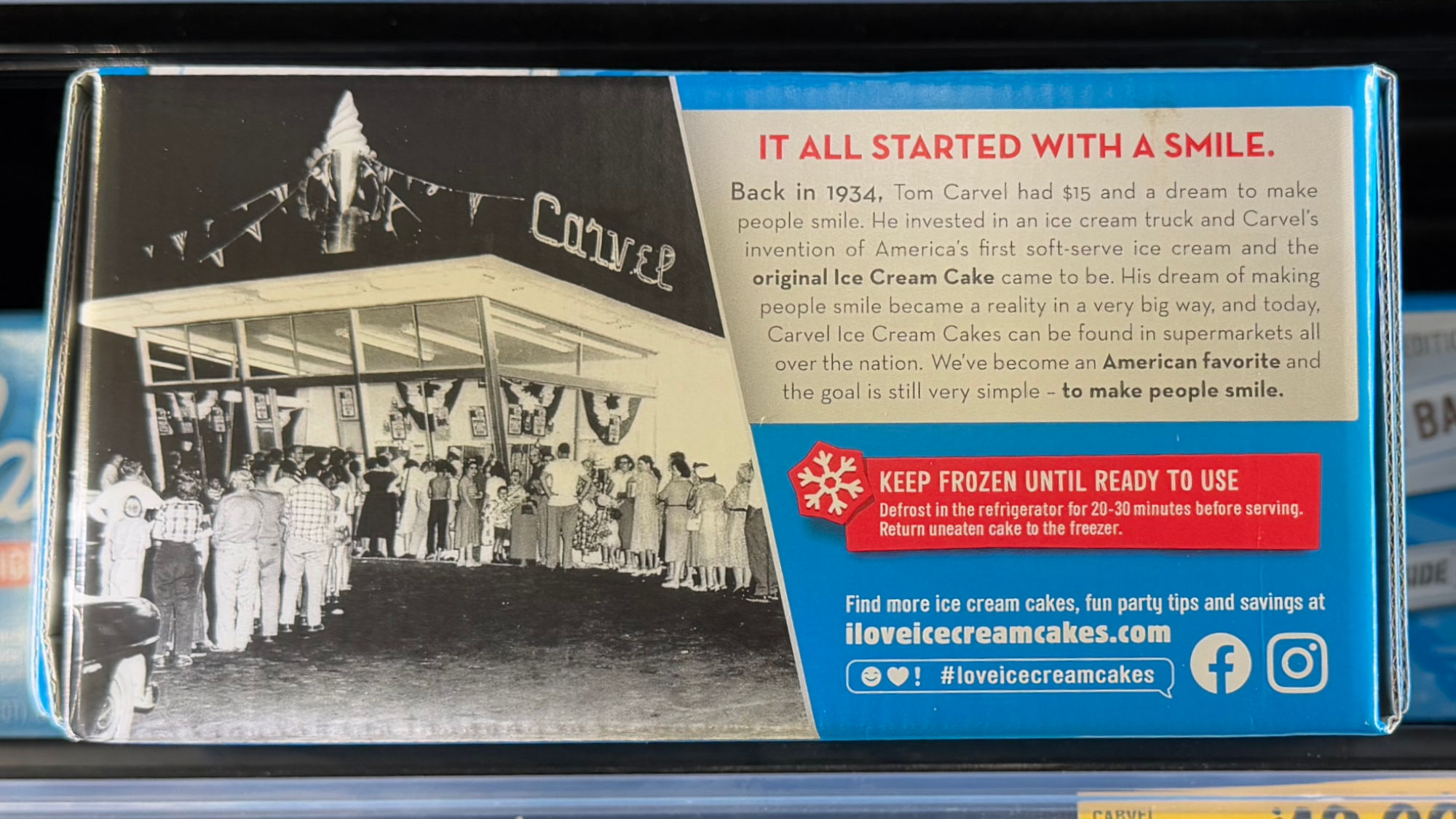
Back in 1934, Tom Carvel had $15 and a dream to make people smile. He invested in an ice cream truck and Carvel's invention of America's first soft-serve ice cream and the original Ice Cream Cake came to be. His dream of making people smile became a reality in a very big way, and today, Carvel Ice Cream Cakes can be found in supermarkets all over the nation. We've become an American favorite and the goal is still very simple - to make people smile.
The Secret History Behind Carvel's Flying Saucers
Is there anything better than a flying saucer from Carvel?Edible Long IslandSeptember, 2019
Once defined as ice cream that's 'sandwiched' between two biscuits, wafers, or cookies, today the frozen treats come in all sorts of shapes, sizes, and levels of portability. It is not uncommon to see waffles, donuts, brownies, cinnamon rolls, cupcakes, funnel cakes, churros, or even weaved bacon, bookending scoops of vanilla, chocolate, and the like.Maybe that's why I was surprised when I had my last ice cream sandwich. It was a Carvel classic, two chewy brown wafer rounds sandwiching a layer of smooth soft-serve, from the brand's "Flying Saucer" line. In the intervening years since my last, I've had good quality ice creams nestled between all sorts of baked goods. When you bite down on the scallop-edged cookies, the distinctive chew is firm yet forgiving, giving way to chocolate ice cream. The Flying Saucer was even better than I remembered.
Depending on whom you ask or what you read, Tom Carvel invented soft-serve ice cream, franchising, several marketing concepts, including "Buy One, Get One Free," and round ice cream sandwiches. As one article featured in the March 1954 The Ice Cream Trade Journal noted, Carvel's Flying Saucer is "the first round ice cream sandwich to be marketed in the modern history of the ice cream business." While not inaccurate, some might call that claim "fluffy" or worse.
The first ice cream sandwich, full stop–vanilla ice cream pressed between two thin graham wafers–made headlines in 1899 when the New York Mail and Express ran a story about the “new” sandwich, notes Jeri Quinzio, author of Sugar and Snow: A History of Ice Cream Making. The treat was revolutionary and rectangular.
Decades later (and decades earlier than Carvel), a man by the name of George Whitney decided to sandwich a scoop of ice cream between two oatmeal cookies. (They were round.) He dipped them in chocolate and sold them at his hot dog and ice cream stand at the now closed, Playland-at-the-Beach in San Francisco. The year was 1928.
It wasn't until 1951, that Carvel introduced the Flying Saucer, a round ice cream sandwich made with vanilla soft-serve ice cream and chocolate wafers sourced from the Empire Biscuit Co., in Brooklyn, NY. (The wafers are now manufactured by Interbake.) But, ambiguity has never been a problem for the ice cream icon.
Even the name Flying Saucer, which Carvel trademarked along with the slogan "Carvel Flying Saucer, they're out of this world," isn't entirely ownable. In 1948, a year after the first widely reported UFO sighting in the United States led the media to coin the term flying saucer, west-coast entrepreneur, Fred Morrison launched an inedible Flyin' Saucer. We know it today as the frisbee. While Lauren Bernath, Sr. Social Media & Public Relations Manager at Carvel, credits the inspiration for the Flying Saucer to the space boom and general enthusiasm around space exploration, she couldn't provide more detail around the product or the name's inception.

Loaded with Crunchies Inside & Out
- Layers of Chocolate & Vanilla Flavored Ice Cream with Thick Rich Fudge, Chocolate Flavored Crunchies and Creamy Whipped Icing
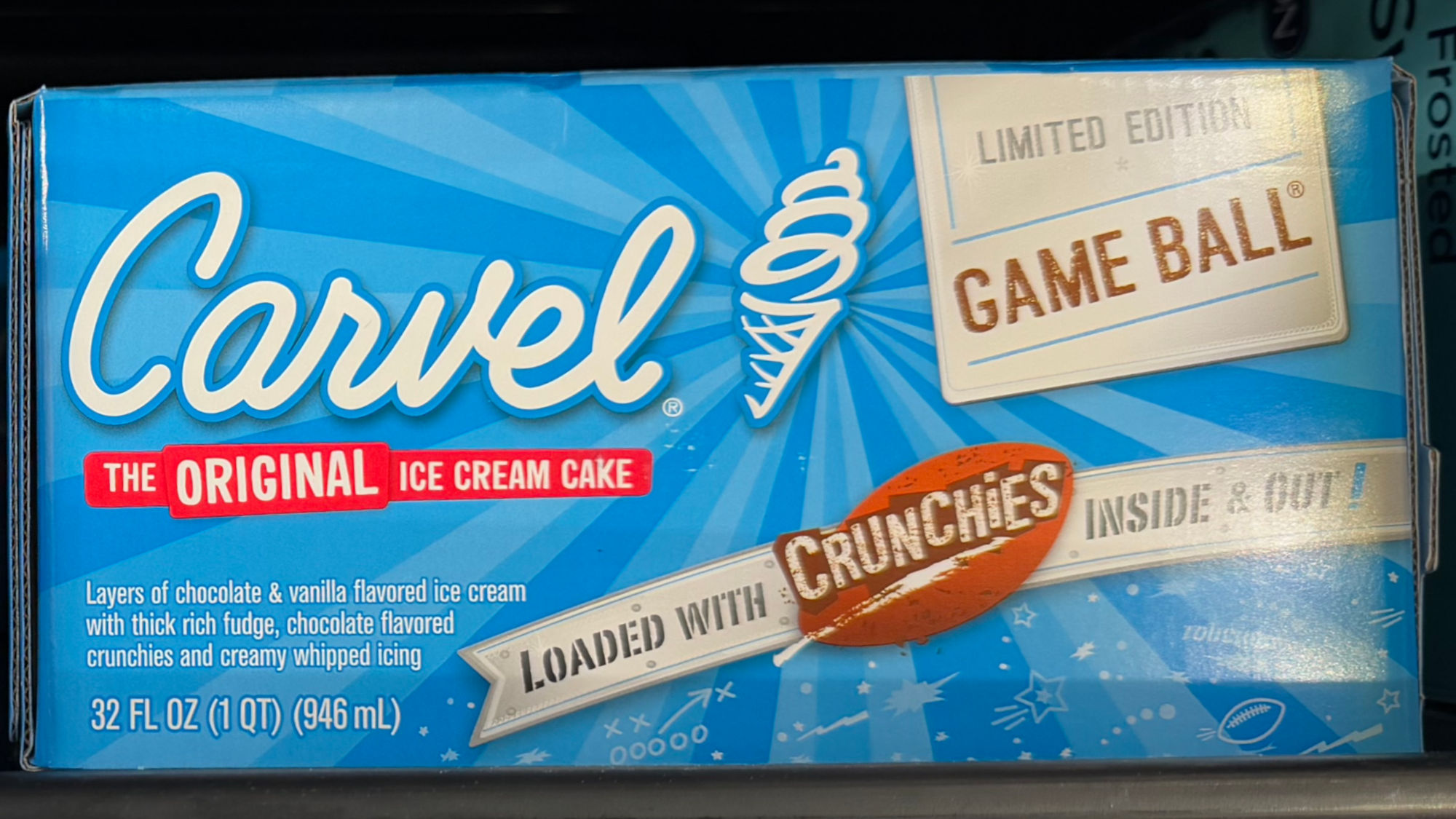
CNNFudgie the Whale
Carvel's vanilla and chocolate-flavored ice cream cake has been a holiday staple since 1977, when it it was first created as a Father's Day promotion, and nearly five decades later, it has earned its place in the pantheon of recognizable fast food characters.Fudgie the Whale wasn't initially produced to be a mascot for the 90-year-old brand. It was made to fill the freezer cases that founder Tom Carvel had made for his shops. Ice cream cakes quickly flew off the shelves, first created in the mid-1950s, and twenty years later he thought of making a cake for Father's Day.
Fudgie was a play on the phrase (more commonly said back then): a "whale of a dad," according to Carvel's Chief Brand Officer Jim Salerno, which prompted Carvel to mass produce Fudgie using a plastic, whale-shaped mold that he invented. He decided to top it with fudge, because it was one of Carvel's most popular toppings.
To make the cake, soft-serve vanilla is placed into the mold first, followed by chocolate chip cookie pieces better known as "crunchies." Then it's topped with soft-serve chocolate ice cream and frozen for several hours. After that, it's topped with hot fudge with more crunchies on the side. The cakes sell for about $30.
Fudgie helped Father's Day become Carvel's busiest day of the year for buying cakes, Salerno said.
JIM SALERNOThe simple reason is when you ask dad what they want to do on Father's Day is that they want to stay home, like watch TV or have a barbecue. It's a big holiday to bring cake home.Fudgie's popularity extends beyond Father's Day, Salerno said, popular for other occasions like birthdays and anniversaries, too. Carvel sells nearly 100,000 Fudgies a year.
Mashed2023
This said ice cream kingdom, fittingly deemed Carvel, continues to create ice cream delights that keep people returning to its franchise castles. Among its offerings are hard scooped ice cream (which is made from the same formula as its OG soft serve), ice cream sandwich flying saucers, and, weirdly, a whale-shaped ice cream cake called Fudgie that was created somewhere along the way. Carvel's repertoire is a sacred space for all who love sweet and creamy treats. But today, we're going to charge Carvel's palace of ice cream fortitude to decide which of its flavors really deserve the title of ice cream royalty and which should be dethroned for a DQ blizzard.We tried 12 Carvel ice cream flavors - two were soft serve and 10 were hard scooped if you want to get technical - at our local shoppe and ranked them . Here are the dreamy and not-so-creamy results.
- Cotton candy scooped
Cotton candy flavored ice cream usually takes a pretty universal form. Light and sugary, its blue and pink flavors are swirled together into a cotton-candy-esque frozen dessert. But those pitiful ice creams are only pretending to be a perfect replica of one of the most famous treats you look forward to getting at the fair. Will the real cotton candy ice cream stand up? Yes, Carvel's cotton candy ice cream is quite literally cotton candy reincarnated into a second, dare we say, tastier life as ice cream.A light pink ice cream filled to the brim with thick, round sprinkles, every bite you take out of Carvel's cotton candy ice cream is saturated with both the fluffy cotton candy flavor of its base and its crunchy, fun add-ins. Most miraculously, however, its light flavor combined with the texture of its round sprinkles remind us of that crunchy, bunched-up part of cotton candy that we all know and love.
Full of round sprinkles and bursting with unmistakable cotton candy flavor, Carvel's cotton candy ice cream is a fan favorite. It's a carnival in your mouth. So call us blasphemous, but when you head to Carvel, skip the soft serve. Our No. 1 pick for Carvel's must-have treat is its hard-scooped cotton candy ice cream.
- Mint chocolate chip scooped
- Strawberry scooped
- Cherry vanilla scooped
- Vanilla soft serve
- Pistachio scooped
- Chocolate soft serve
- Cold brew coffee scooped
- Cake mix scooped
- Oreo cookies and cream scooped
- Chocolate chip cookie dough scooped
- Mixed chocolate vanilla scooped
Roadside ArchitectureCarvel claims to have designed the pitched roof and sheet glass front which became the standard for ice cream stands. Carvel was founded in 1934. By 1952, there were 125 locations operating between Maine and Florida. The following year, there were more than 250 stores between Maine and Wisconsin.
This Carvel in Hartsdale was the first location built. It opened in 1936 and featured car hops. This all-glass front, pitched roof building was a later addition to the front of the original store. Carvel developed this design in 1947. At some point, the company had ice cream trucks which mimicked these buildings. In 2008, this location closed and the building was demolished in 2009.
Greek heraldJuly, 2020
Greek American businessman, Tom Carvel (born Athanasios Karvelas), created America's first ice cream franchise and is well-known as the inventor of soft serve ice cream. We take a look back at how a flat tire on his truck led to his successful career.After borrowing $15 from his then girlfriend and future wife Agnes Stewart, Carvel began selling ice cream from the back of his battered truck.
Some bad luck on Memorial Day weekend in 1934 turned out to be a blessing in disguise for Carvel. When his truck suffered a flat tire, he pulled his trailer into a parking lot next to a pottery store and began selling his melting ice cream to vacationers driving by.
Carvel sold his entire supply of ice cream in just two days. This is when he realised he could make a lot more money working from a fixed location.
The potter allowed Carvel to hook into his store's electricity. Two years later, in 1936, Carvel bought the pottery store, converted it into a roadside stand, and permanently established himself as the nation's first retailer of soft serve ice cream.
That same year, he patented a "no air pump" super-low temperature ice cream machine, developed a secret soft serve ice cream formula and introduced the marketing concept "Buy one get one free."
In 1939, Carvel built the first soft serve ice cream machine.
As Carvel began selling his patented machinery to other stores, he quickly realised that he could sell not only his machinery, but also his expertise.
For a flat fee and a percentage of the profits, Carvel began teaching independent storeowners the ropes and allowed them to market ice cream under the Carvel name. Carvel cultivated this relatively unknown idea called “franchising,” and opened 25 stores by the early 1950's.
On October 21, 1990, Carvel passed away at age 84. Although he was married, he had no children and his death led to litigation between his relatives and his lawyers.
He left behind him a big fortune, a huge brand with 400 stores around the world, and a myth of entrepreneurship and business strategy taught to this day in business seminars in America. It all started with an accident, a flat tire, which Tom managed to reverse, turning the “American Dream” into reality.
Greek ReporterAthanassios Karvelas
Tom Carvel, born Athanassios Karvelas in Athens, was brought to the United States as a child from his native Greece. The Greek immigrant was the man who invented soft ice cream in the US and whose name became a legend there. Carvel Ice Cream is among the best known brands in the U.S., with over five hundred stores and a broad online business profile. For decades, its founder, Tom Carvel, was a household name.He had created the formula to make what became known as soft-serve ice cream. His store was the very first anywhere that sold soft ice cream.
Unlike the traditional ice cream of the time, "soft ice cream" was made by a secret formula based on a pastry cream invented by Carvel. The mixture was kept in the machine at a very low temperature, but without freezing it, like the traditional cone or boxed ice cream.
During that same year of 1936, Carvel presented his patented machine which made fresh, soft ice cream and established the Carvel Corporation.
The idea was very successful from the get-go, and, over the next eleven years, Carvel sold his "Miracle Machines" to countless ice cream stores across the United States.
Building an Ice-Cream Empire
However, many shopkeepers found it difficult to handle his machines properly, so the ice cream mogul came upon the solution of visiting his clients in person and advising them on how their machines should work.In 1947, Carvel came up with the idea to have his own name on ice cream stores across the nation. After all, many of them were already using his own, patented machines.
His idea of creating soft ice cream outlets under his own name, as well as his advice to shopkeepers, can be compared to the type of commercial entity we nowadays know as a franchise. His first franchise opened that year, and by 1951, there were a hundred Carvel Ice Cream stores across America.
Another novelty which made Greek-American entrepreneur Carvel famous was that he was one of the first company executives to be the central person in the advertising of his products.
Ads with his distinctive voice were broadcast on the radio and then continued on television. The man with a white mustache became a well-known figure in most American homes.
Carvel's company then began making ice cream cakes in novelty shapes. The whale ice cream cake, as well as his festive Santa Claus ice cream cakes, became great hits-all true to the great reputation of his fresh, soft ice cream, of course.
Tom Carvel passed away in 1990 at the age of eighty-four, leaving behind a hugely-successful company with five hundred stores-and a legacy of making people happy with his ice cream. Carvel Ice Cream is just another of the many tales of success in the history of Greek-Americans.
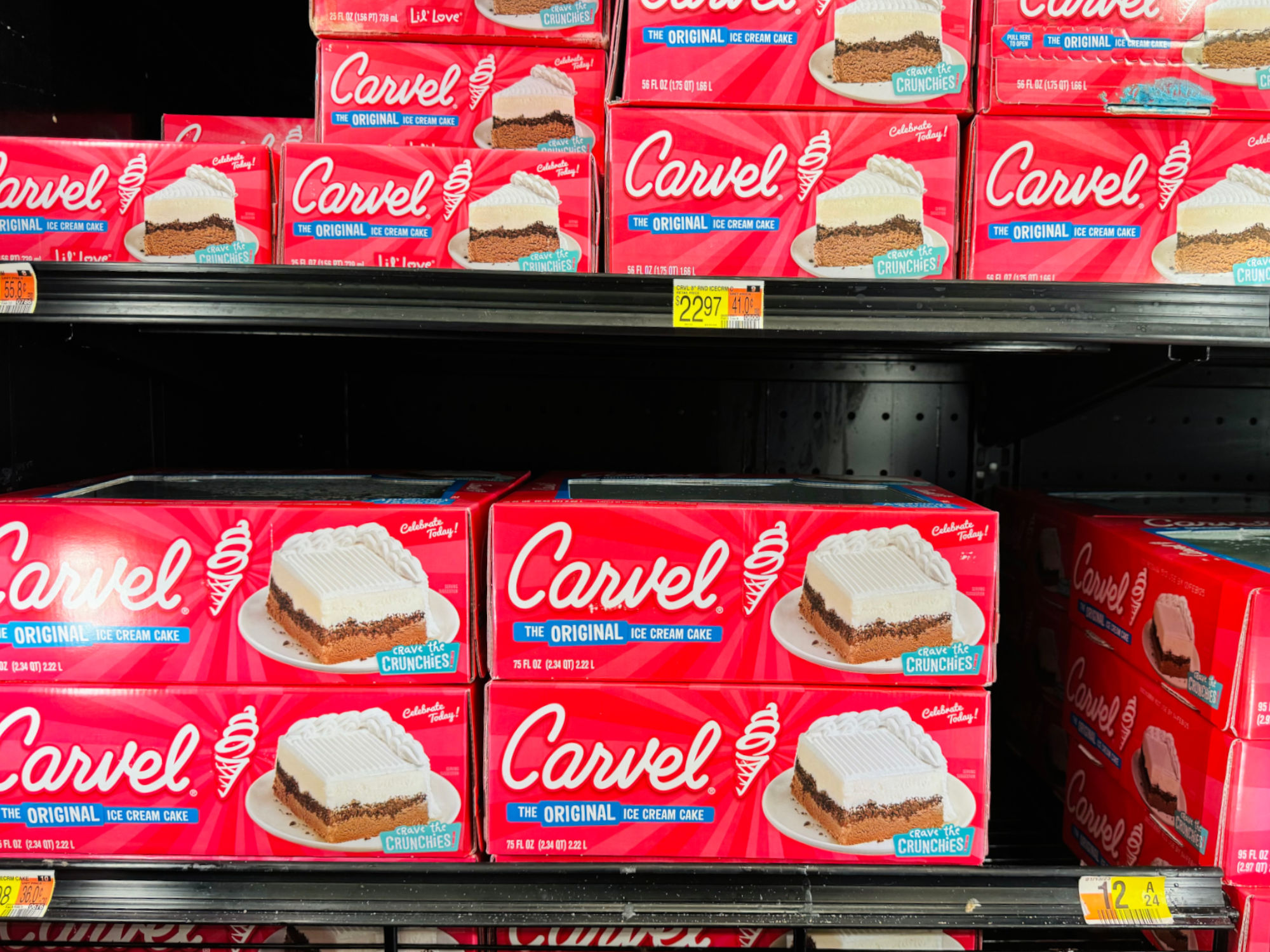
Spoon UniversityMay 2024
As summer approaches, so does the return of everyone's favorite treat to eat in the heat: ice cream. There's nothing better than a giant scoop of ice cream on a sweltering day. Not only is it refreshing on those hot days, but it also tastes delicious. And who does ice cream better than Carvel? Known for its ice cream and soft serve, as well as shakes, cakes, and sundaes, Carvel is the go-to spot for everything ice cream.Carvel is also recognized for its wide variety of flavors, with over 20 different flavors to choose from. It's almost impossible to pick which ice cream to order when you walk in. It can get pretty overwhelming, to be honest. As someone who frequents Carvel every summer, I've become an expert on navigating the many flavors. To make it easier to decide which of the many flavors to get, here's a list of Carvel's flavors, ranked from least craveable to most delicious.
- Chocolate Chip Cookie Dough
Nothing is better than taking a bite of creamy, vanilla ice cream and getting a chunk of soft cookie dough. It tastes just like pre-oven cookie dough. So, this is the superior flavor.- Birthday Cake
Everyday can be your birthday with this flavor. It has their signature Birthday Cake Crunchies mashed into it, making it taste identical to a birthday cake.- Vanilla
You can't go wrong with classic vanilla, and Carvel's is delectable. In fact, it was Carvel's vanilla flavor that launched them as a premium ice cream. It's where it all started, so of course it's delicious!- Cake Mix
Think of boxed cake mix, but an ice cream version. That's what this amazing flavor tastes like, and it has sprinkles. It's a celebration right in your cone.- Chocolate Chip
Chocolate chip is universally known as one of the best ice cream flavors, and Carvel takes it to another level. The chocolate chips spread throughout the classic vanilla flavor makes for both a creamy and crunchy treat.- Cotton Candy
With its bright pink appearance and colorful sprinkles, the cotton candy flavor tastes even better than how it looks. It's one of Carvel's most popular flavors!- Oreo Cookies & Cream
- Chocolate Hazelnut
- Lemonade Sorbet
- Chocolate
- Vanilla Fudge Swirl
- Peanut Butter Treasure
- Pistachio
- Mint Chocolate Chip
- Orange Tangerine Sorbet
- Strawberry
- Cold Brew Coffee
- Raspberry Sorbet
- Dragon Fruit Lemonade Sorbet
- Pink Grapefruit Sorbet
- Butter Pecan
- Cherry Vanilla
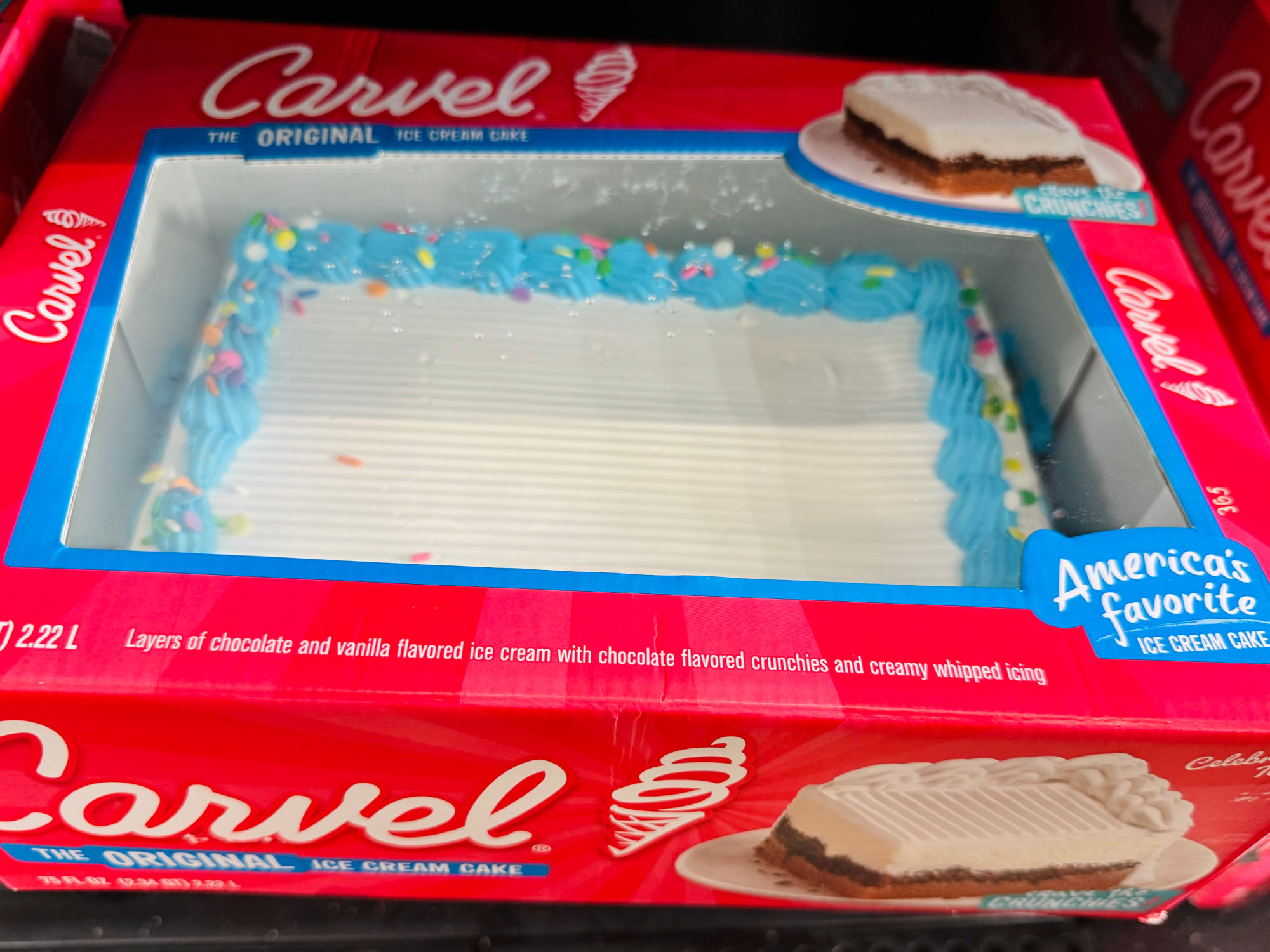
Smithsonian InstituteScope and Contents
The records provide rich research material on many stories, including: American invention, enterprise, and entrepreneurship; the origins and growth of franchising; popular food and culture; the development of roadside architecture; radio and television advertising; product marketing and promotion; regional studies; and gender issues such as beauty pageants and the role of women in the labor force.The Carvel Corporation is an American success story. Through hard work and timely luck, its founder and president, Tom Carvel, turned an ice cream trailer with a flat tire into an international chain of ice cream supermarkets with over 800 outlets in 17 states and six countries. Thomas Andreas Carvelas was born July 14, 1906, in Athanassos, Greece. He was one of seven children of Andreas and Christina Karvelas. The family emigrated from Greece to Danbury, Connecticut, in 1910, and finally settled in New York City in 1920. His father was a chemist and wine specialist who helped support his family during prohibition by restoring fermented wine for Greek restaurant owners.
Tom's father sparked Tom's interest in how things worked. Tom tried his hand as a salesman of radios and automobiles, a test driver for Studebaker, and an auto mechanic. At the age of twenty-six, he was diagnosed with tuberculosis, and his doctors advised him to move out of the city. Consequently, he borrowed $1,000 from relatives and built a frozen custard trailer. His first break came on Memorial Day, 1934, when he borrowed $20 from Agnes Stewart (his future wife), bought a trailer load of custard, and set out to sell it to vacationers in Westchester County, New York. Tom Carvel suffered a minor setback when his trailer had a flat tire in Hartsdale, New York. But luck was on his side: there was a pottery shop across the street and Pop Quinlan, the potter, allowed him to use his electricity so the custard would not melt.
Tom Carvel kept his trailer on the pottery shop's lot and in his first year grossed $3,500. The following year, realizing that a permanent location could be profitable, he leased the shop for $100. In 1937, he borrowed more money and converted the trailer into a frozen custard stand, complete with a second-hand freezer which enabled him to make his own custard. By 1939, he was grossing $6,000 a year and was well on his way toward becoming the "Ice Cream King of the East." In the early 1940s Agnes, his wife, operated the Hartsdale store while Carvel traveled the carnival circuits selling his frozen custard from a mobile vending vehicle. Next, he managed the ice cream cone stands at the post exchange at Fort Bragg, North Carolina.
Tom Carvel soon developed his own freezer model, known as a batch freezer, (the first of his sixteen U.S. Patent Registrations). In 1947, he sold 71 freezers at $2,900 each under the trade name "Custard King." When some owners defaulted on their payments Carvel discovered that many of the freezer owners were careless in their selection of locations, disregarded cleanliness, and worked sporadically, while others were selling additional, non-ice cream food items. Determined to make the venture succeed, he decided to oversee the operations of the freezer owners directly. He claimed to have developed the franchise concept in 1949 as a result of this strategy.
Franchise business opportunities allow investors to enter retailing without prior business experience and to own their own business. In the case of the Carvel Corporation, potential franchise owners bought equipment and supplies from the Corporation and used the Carvel name. In return, Carvel helped them select a location, taught them how to run an ice cream business, and organized resources for advertising and promotions. Franchise owners were taught the retail ice cream business at the Carvel College, an 18-day series of courses for potential store owners. There they learned about public relations, mechanics of the ice cream machines, local advertising, and making and freezing all kinds of ice cream cakes. They also received The Shopper's Road, an in-house magazine advising them on topics ranging from travel tips, to cooking, to marketing their products to the community.
From the beginning, the Carvel Dairy Freeze Chain stressed cleanliness, hard work, and a quality, all-natural product. Tom Carvel aimed to create a family-type environment for his franchise owners. He wanted people who would work hard and were eager to learn about the retail ice cream business in order to make their individual rags to riches stories come true. A unique and important element to the Carvel story was Tom Carvel's personal involvement - from an early date - in creating commercials for the stores. His was one of the first instances in which a Chief Executive Officer of a major corporation was featured in his company's commercials. In 1955, Carvel began making his own radio commercials. As the story goes, one day while driving in New York City he heard a commercial for a new Carvel store, but the announcer did not state its exact location. Convinced he could do a better job, he drove to the radio station and re-did the commercial himself. After this incident he started doing his own commercials on a full-time basis. Tom Carvel created a distinct style with his garbled delivery and "say it once" philosophy, with the idea that you have to grab people's attention and then let the product speak for itself. Carvel eventually set up an in-house production studio and advertising agency at the Carvel Inn, where most of his television and radio commercials were made.
The use of premiums was an essential marketing component for Carvel. In 1936, he introduced the "Buy One Get One Free" offer. He also used comic books, ice cream eating contests, and a beauty pageant for young girls, called the "Little Miss Half Pint Contest," to attract children. The Carvel Corporation also participated as a corporate sponsor for events like Walt Disney's "Great Ice Odyssey," "Carvel Night at the Rodeo," and numerous promotional tie-ins with the New York Yankees baseball team. Of all the sales promotions, it was the specialty products which brought the greatest notoriety to the Carvel name. From the "Flying Saucer" ice cream sandwich and the "Papapalooza" to the holiday and character ice cream cakes, customers could always count on a quality product. There were ice cream cakes for every holiday, including a "Flower Basket" for Mother's Day, "Fudgie the Whale" for Father's Day, "Tom the Turkey" for Thanksgiving, and a "Snow Man" for Christmas. Eventually, a customer could special order an ice cream cake for any occasion, using a toll-free phone number.
The Carvel Corporation enjoyed continued success and consistent expansion marked by Tom Carvel's innovative concepts in marketing. For example, in 1956, the Hartsdale location was converted into the first ice cream supermarket. Each store remained a full-service ice cream parlor, but now had the added convenience of self-serve freezers where customers could select ice cream specialty products such as Flying Saucers, Carvelogs, Brown Bonnets, and ice cream cakes.
In 1962, the Corporation experienced a crisis. Many franchise owners had begun buying cheaper ingredients and the chain was reduced to 175 stores. This potentially meant financial catastrophe for Tom Carvel and the company because it derived its profits from selling equipment and special mixes to store owners. Carvel insisted the franchise owners had obligations to the company and its customers to provide a uniform, quality product. Furthermore, the franchise owners had agreed to purchase raw ingredients from Carvel. When the Corporation tried to enforce this agreement, the Federal Trade Commission charged Carvel with allegations of coercion and restraint of trade. In 1964, after presenting his side before the full Federal Trade Commission and the Supreme Court, he won his case.
In 1967, Carvel purchased the Westchester Town House Motel, in Yonkers, New York, and changed the name to the Carvel Inn. It was both a full-service motel and the Executive Offices of the Carvel Corporation. It was here that store owners gathered for the annual educational seminars which reinforced the ideas taught by the Carvel College.
In the 1950s Tom Carvel had also developed the franchise concept for a hamburger chain called Hubie Burger. It served hamburgers, french fries, chicken, and waffles. It is ironic that Carvel began the Hubie Burger chain because at a dairy convention in 1956, Ray Kroc asked him if he was interested in setting up the McDonald's chain. It is said that at this time Carvel felt ice cream and hamburgers did not compliment each other and declined the offer. However, Carvel claimed to have given McDonald's permission to use the basic text of his franchise contract and his building design as models. Later, Carvel acquired Dugan's Bakery. However, neither Dugan's nor Hubie Burger was very successful.
Through his strong work ethic, creativity, and perseverance, Tom Carvel built up his ice cream chain and turned his dreams into reality. His achievements were recognized in 1957 when he was awarded the Horatio Alger Award. Carvel credited his success to his father and his wife, Agnes. His father sparked his interest in chemistry and engineering and his wife worked in the first Carvel store, which allowed him time to develop the Carvel Corporation Franchise System. In 1989, he sold the Carvel Corporation to an international investment company, Investcorp, for more than 80 million dollars. Tom Carvel died in 1990. The Carvel name lives on through the Carvel Ice Cream Bakery Company, operated by Investcorp.
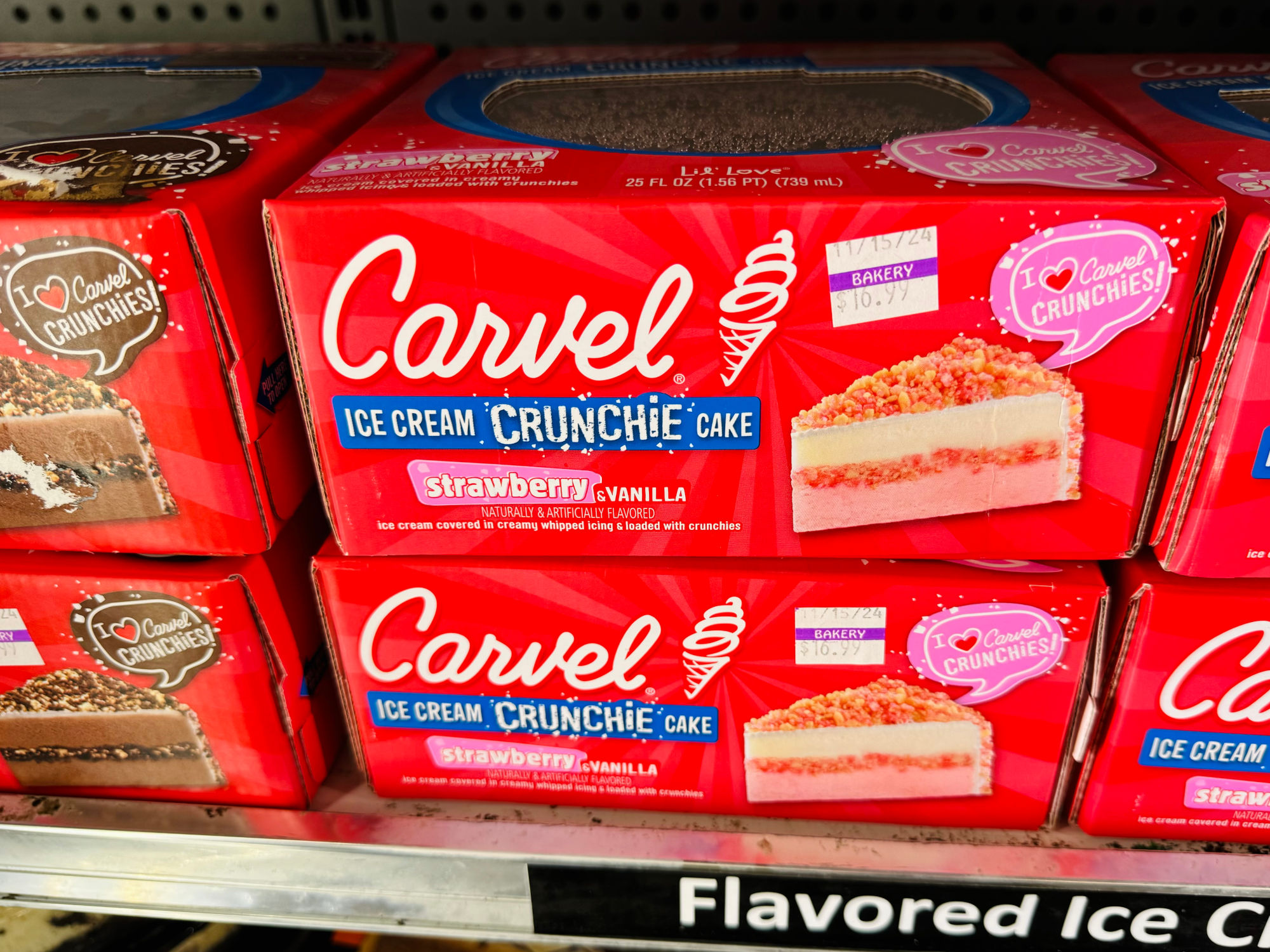
iloveicecreamcakes.comCarvel Ice Cream
Carvel has been in the ice cream business for nearly 100 years. That's a lot of ice cream and a lot of ice cream cakes. If you're looking for the best ice cream cake with the creamiest ice cream and the most delicious cake, then Carvel is the answer. Our cakes are sold nationwide and are loved by loyal customers everywhere. If you haven't tried one, today's the day to find out what 100 years of fuss is all about.While Carvel has been synonymous with great ice cream cake for decades, not many people know Carvel started in an ice cream truck on a humble $15 loan to get the business up and running. Here are 5 more Carvel Ice Cream Cake facts that you may not know:
- Carvel Started from a $15 Investment
Tom Carvel borrowed $15 to buy an ice cream truck when he was only 28 years old. Funnily enough, the lovely person who loaned him the money was a woman named Agnes, who later became his wife. The year was 1929, and it's unknown whether or not Tom ever paid Agnes that $15 back. Either way, we think it was a wise investment.- Carvel's Famous Ice Cream was Created by Mistake
While out delivering ice cream, Carvel got a flat tire and was forced to pull over into a parking lot near a pottery store. As his ice cream began to melt, he decided to sell it to locals passing by so it wouldn't go to waste. As it turned out, people loved the softer ice cream. In fact, they loved it so much that he sold his entire inventory in two days! With this realization, he eventually created and patented his own freezer to make softer ice cream, and eventually, delicious ice cream cake.- The First Shop was Built Where Carvel's Truck Broke Down
Eight years after he bought his truck, Carvel managed to build his first shop. Ironically, Carvel ended up purchasing and converting the same pottery store he parked next to all those years before.- Their Most Famous Ice Cream Cake is Iconic
Fudgie the Whale is an icon, and easily most famous Carvel creation. The story goes that they were trying to take a picture of a whale cake to use for some advertising, but the tail wouldn't stay attached. Improvising, they covered it in fudge icing to keep the tail in place. The new ingredient helped keep the appendage in place, but it ultimately became the defining trait of this mouth-watering ice cream cake.- Carvel Has Broken Multiple Guinness World Records
As a company, Carvel has a place in the Guinness Book of World Records for having broken two records. They hold the record for the largest ice cream scoop pyramid as well as the largest ice cream cake. Those in attendance for the events got to indulge in delicious record-breaking goodness.
